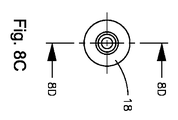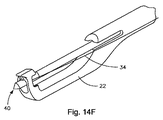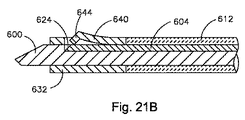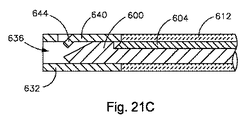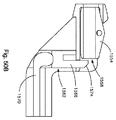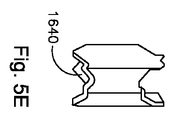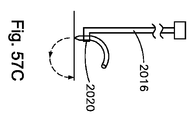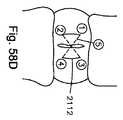JP2012515636A - Bi-directional suture threader - Google Patents
Bi-directional suture threader Download PDFInfo
- Publication number
- JP2012515636A JP2012515636A JP2011548214A JP2011548214A JP2012515636A JP 2012515636 A JP2012515636 A JP 2012515636A JP 2011548214 A JP2011548214 A JP 2011548214A JP 2011548214 A JP2011548214 A JP 2011548214A JP 2012515636 A JP2012515636 A JP 2012515636A
- Authority
- JP
- Japan
- Prior art keywords
- needle
- reciprocating element
- boom arm
- arm housing
- threading device
- Prior art date
- Legal status (The legal status is an assumption and is not a legal conclusion. Google has not performed a legal analysis and makes no representation as to the accuracy of the status listed.)
- Abandoned
Links
Images
Classifications
-
- A—HUMAN NECESSITIES
- A61—MEDICAL OR VETERINARY SCIENCE; HYGIENE
- A61B—DIAGNOSIS; SURGERY; IDENTIFICATION
- A61B17/00—Surgical instruments, devices or methods, e.g. tourniquets
- A61B17/04—Surgical instruments, devices or methods, e.g. tourniquets for suturing wounds; Holders or packages for needles or suture materials
-
- A—HUMAN NECESSITIES
- A61—MEDICAL OR VETERINARY SCIENCE; HYGIENE
- A61B—DIAGNOSIS; SURGERY; IDENTIFICATION
- A61B17/00—Surgical instruments, devices or methods, e.g. tourniquets
- A61B17/04—Surgical instruments, devices or methods, e.g. tourniquets for suturing wounds; Holders or packages for needles or suture materials
- A61B17/0482—Needle or suture guides
-
- A—HUMAN NECESSITIES
- A61—MEDICAL OR VETERINARY SCIENCE; HYGIENE
- A61B—DIAGNOSIS; SURGERY; IDENTIFICATION
- A61B17/00—Surgical instruments, devices or methods, e.g. tourniquets
-
- A—HUMAN NECESSITIES
- A61—MEDICAL OR VETERINARY SCIENCE; HYGIENE
- A61B—DIAGNOSIS; SURGERY; IDENTIFICATION
- A61B17/00—Surgical instruments, devices or methods, e.g. tourniquets
- A61B17/04—Surgical instruments, devices or methods, e.g. tourniquets for suturing wounds; Holders or packages for needles or suture materials
- A61B17/0469—Suturing instruments for use in minimally invasive surgery, e.g. endoscopic surgery
-
- A—HUMAN NECESSITIES
- A61—MEDICAL OR VETERINARY SCIENCE; HYGIENE
- A61B—DIAGNOSIS; SURGERY; IDENTIFICATION
- A61B17/00—Surgical instruments, devices or methods, e.g. tourniquets
- A61B17/04—Surgical instruments, devices or methods, e.g. tourniquets for suturing wounds; Holders or packages for needles or suture materials
- A61B17/06—Needles ; Sutures; Needle-suture combinations; Holders or packages for needles or suture materials
-
- A—HUMAN NECESSITIES
- A61—MEDICAL OR VETERINARY SCIENCE; HYGIENE
- A61B—DIAGNOSIS; SURGERY; IDENTIFICATION
- A61B17/00—Surgical instruments, devices or methods, e.g. tourniquets
- A61B17/04—Surgical instruments, devices or methods, e.g. tourniquets for suturing wounds; Holders or packages for needles or suture materials
- A61B17/06—Needles ; Sutures; Needle-suture combinations; Holders or packages for needles or suture materials
- A61B17/062—Needle manipulators
- A61B17/0625—Needle manipulators the needle being specially adapted to interact with the manipulator, e.g. being ridged to snap fit in a hole of the manipulator
-
- A—HUMAN NECESSITIES
- A61—MEDICAL OR VETERINARY SCIENCE; HYGIENE
- A61B—DIAGNOSIS; SURGERY; IDENTIFICATION
- A61B17/00—Surgical instruments, devices or methods, e.g. tourniquets
- A61B17/56—Surgical instruments or methods for treatment of bones or joints; Devices specially adapted therefor
-
- A—HUMAN NECESSITIES
- A61—MEDICAL OR VETERINARY SCIENCE; HYGIENE
- A61B—DIAGNOSIS; SURGERY; IDENTIFICATION
- A61B17/00—Surgical instruments, devices or methods, e.g. tourniquets
- A61B17/04—Surgical instruments, devices or methods, e.g. tourniquets for suturing wounds; Holders or packages for needles or suture materials
- A61B17/06—Needles ; Sutures; Needle-suture combinations; Holders or packages for needles or suture materials
- A61B17/06066—Needles, e.g. needle tip configurations
-
- A—HUMAN NECESSITIES
- A61—MEDICAL OR VETERINARY SCIENCE; HYGIENE
- A61B—DIAGNOSIS; SURGERY; IDENTIFICATION
- A61B17/00—Surgical instruments, devices or methods, e.g. tourniquets
- A61B2017/00477—Coupling
-
- A—HUMAN NECESSITIES
- A61—MEDICAL OR VETERINARY SCIENCE; HYGIENE
- A61B—DIAGNOSIS; SURGERY; IDENTIFICATION
- A61B17/00—Surgical instruments, devices or methods, e.g. tourniquets
- A61B2017/00831—Material properties
- A61B2017/00867—Material properties shape memory effect
-
- A—HUMAN NECESSITIES
- A61—MEDICAL OR VETERINARY SCIENCE; HYGIENE
- A61B—DIAGNOSIS; SURGERY; IDENTIFICATION
- A61B17/00—Surgical instruments, devices or methods, e.g. tourniquets
- A61B17/04—Surgical instruments, devices or methods, e.g. tourniquets for suturing wounds; Holders or packages for needles or suture materials
- A61B2017/0496—Surgical instruments, devices or methods, e.g. tourniquets for suturing wounds; Holders or packages for needles or suture materials for tensioning sutures
Abstract
垂直に軟部組織に接近するように構成された双方向縫合糸通し器具は、より安全かつより効率的な外科的修復及び低侵襲性技術を使用することを可能にし、環修復、半月板修復、肩関節鏡検査、ヘルニア修復、腹腔鏡修復、及び創傷閉鎖のような分野に有用である。
【選択図】 図1BA bi-directional suture passer configured to access soft tissue vertically allows for safer and more efficient surgical and minimally invasive techniques to be used, ring repair, meniscal repair, Useful in fields such as shoulder arthroscopy, hernia repair, laparoscopic repair, and wound closure.
[Selection] Figure 1B
Description
〔関連出願への相互参照〕
本出願は、2009年1月26日出願の米国特許仮出願第61/147,251号明細書に対する優先権を請求するものであり、この特許の内容は、その全体が引用により組み込まれている。
[Cross-reference to related applications]
This application claims priority to US Provisional Application No. 61 / 147,251, filed Jan. 26, 2009, the contents of which are incorporated by reference in their entirety. .
縫合糸通しは、軟部組織欠損部の修復に利用される。縫合糸は、典型的には、外科手術に使用される自由針又は一方向縫合糸通し器具(一方向だけに組織に縫合糸を通す器具)に取り付けられる。 Suture threading is used to repair soft tissue defects. Sutures are typically attached to free needles or one-way suture threading instruments (instruments that thread the tissue in only one direction) used in surgery.
双方向縫合糸通し器具、すなわち、前方方向(ユーザから離れて)かつ後方方向(ユーザに向けて)に組織に縫合糸を通すことができる器具は、一方向縫合糸通し器具に勝るいくつかの利点を有することができる。多くの一方向縫合糸通し具は、手動で縫合糸を取り出して逆方向に通す付加的な段階を必要とし、従って、外科技術及び処置時間の複雑性が増大する。一部の一方向縫合糸通し具の設計は、縫合糸を通すための器具による取出し及び取替えを考慮するものであるが、これらの設計は、逆方向に縫合糸を通すために器具の遠位端に組織の第1及び第2の側を露出するために持ち上げることができるほど組織がしなやかであることを必要とし、縫合糸を取り替える付加的な段階も必要である。双方向縫合糸通し器具は、手動の取出し段階を排除し、外科技術及び処置時間の複雑性を低減し、利用することができる様々な縫い目構成を強化し、且つ、外科的に修復することができる身体組織の数を増大させるものである。 Bi-directional suture passers, ie, devices that can pass suture through tissue in the anterior direction (away from the user) and in the posterior direction (toward the user), have several advantages over unidirectional suture passers. Can have advantages. Many unidirectional suture passers require an additional step of manually removing the suture and passing it in the reverse direction, thus increasing the complexity of the surgical technique and procedure time. Some unidirectional suture threader designs allow for removal and replacement by an instrument for threading sutures, but these designs are designed to allow distal threading of the instrument to thread sutures in the opposite direction. The tissue needs to be supple enough to be lifted to expose the first and second sides of the tissue at the ends, and an additional step of replacing the suture is also required. The bi-directional suture threader eliminates the manual removal step, reduces the complexity of the surgical technique and procedure time, enhances the various seam configurations that can be utilized, and can be surgically repaired. It increases the number of body tissues that can be made.
当業技術で公知の一部の双方向縫合糸通し具設計は、組織欠損部に組織とほぼ平行に接近することを必要とし、これは、椎間板腔への外科的接近のために椎間板環修復のような多くの外科的処置には困難である。従って、ほぼ垂直に組織欠損部に接近する器具を使用する双方向縫合糸通しを可能にする縫合糸通しデバイスを構成することが望ましいであろう。 Some bi-directional suture threader designs known in the art require the tissue defect to be approached substantially parallel to the tissue, which is a disc ring repair due to surgical access to the disc space. Are difficult for many surgical procedures such as Accordingly, it would be desirable to construct a suture threading device that allows bi-directional suture threading using an instrument that approaches a tissue defect substantially vertically.
更に他の双方向縫合糸通し具設計では、鋭い針先端を両方の方向に組織に通すことを必要とする。この針通しは、一方の方向では目で見え、他方の方向では目で見えず、これは、神経根、血管、腸、又は他の敏感な解剖学的構造の近くの区域で作業する時に外科的合併症をもたらす場合がある。従って、組織に通す度に鋭い針が目で見えることを可能にし、それによって敏感な解剖学的構造の区域で作動する時の外科的安全が増大する双方向縫合糸通し器具を構成することも望ましいと考えられる。 Still other bi-directional suture threader designs require a sharp needle tip to pass through tissue in both directions. This needle-through is visible in one direction and not visible in the other, which is a surgical operation when working in areas near nerve roots, blood vessels, intestines, or other sensitive anatomy. May cause complications. Thus, it is also possible to construct a bi-directional suture threader that allows a sharp needle to be visible each time it is passed through tissue, thereby increasing surgical safety when operating in areas of sensitive anatomy. It is considered desirable.
更に、現行の双方向縫合糸通し具設計は、縫合糸を針に効率的に取外し可能に連結しない。従って、縫合糸を針に取外し可能に連結し、それによって器具の効率が改善する新たな機能を構成することが望ましいであろう。 Furthermore, current bi-directional suture threader designs do not efficiently removably connect the suture to the needle. Accordingly, it would be desirable to construct a new function that removably couples the suture to the needle, thereby improving the efficiency of the instrument.
軟部組織欠損部に接近するように構成された双方向縫合糸通し器具の様々な実施形態を開示する。一実施形態では、双方向縫合糸通し器具は、本体部材、本体部材の遠位端から延びるブームアーム、及び前進位置と後退位置の間で本体部材の針受け取りチャンネル内で往復平行移動可能な針を含むことができる。ブームアームは、本体部材から離間したブームアームハウジングを含むことができ、ブームアームハウジング及び本体部材の間には、組織受け取り間隙を配置することができる。ブームアームハウジングは、ロッキングインタフェースを形成することができ、針は、係合特徴部を形成することができる。往復要素は、針及びブームアームハウジングの両方に取外し可能に連結可能とすることができる。その点に関して、往復要素は、針の係合特徴部に対応する係合特徴部と、ブームアームハウジングのロッキングインタフェースに対応するロッキング機構とを含むことができる。針の回転により、針の係合特徴部は、往復要素の係合特徴部と係合し、それによって針に往復要素を取外し可能に連結する。針及び往復要素の両方の回転により、往復要素のロッキング機構は、ブームアームハウジングのロッキングインタフェースと係合し、それによってブームアームハウジングに往復要素を取外し可能に連結する。 Various embodiments of a bi-directional suture threader configured to access a soft tissue defect are disclosed. In one embodiment, the bi-directional suture threader includes a body member, a boom arm extending from a distal end of the body member, and a needle that is reciprocally translatable within a needle receiving channel of the body member between an advanced position and a retracted position. Can be included. The boom arm can include a boom arm housing spaced from the body member, and a tissue receiving gap can be disposed between the boom arm housing and the body member. The boom arm housing can form a locking interface and the needle can form an engagement feature. The reciprocating element can be removably connectable to both the needle and the boom arm housing. In that regard, the reciprocating element can include an engagement feature corresponding to the needle engagement feature and a locking mechanism corresponding to the locking interface of the boom arm housing. By rotation of the needle, the engagement feature of the needle engages with the engagement feature of the reciprocating element, thereby removably connecting the reciprocating element to the needle. By rotation of both the needle and the reciprocating element, the reciprocating element locking mechanism engages the locking interface of the boom arm housing, thereby removably coupling the reciprocating element to the boom arm housing.
別の実施形態では、縫合糸通し器具は、本体部材、本体部材から延びるブームアーム、及び前進位置と後退位置の間で本体部材の針受け取りチャンネル内で往復平行移動可能な針を含むことができる。ブームアームは、組織受け取り間隙がその間に形成されるように本体部材から離間したブームアームハウジングを含むことができる。ブームアームハウジングは、ロッキングインタフェースを形成し、針は、チャンネルと、延長位置と後退位置の間でチャンネル内に配置された係合特徴部とを含むことができる。延長位置にある時に、係合特徴部は、針に往復要素を取外し可能に連結することができ、後退位置にある時に、係合特徴部は、往復要素を針から分離する。 In another embodiment, a suture threading device can include a body member, a boom arm extending from the body member, and a needle that is reciprocally translatable within a needle receiving channel of the body member between an advanced position and a retracted position. . The boom arm can include a boom arm housing spaced from the body member such that a tissue receiving gap is formed therebetween. The boom arm housing forms a locking interface, and the needle can include a channel and an engagement feature disposed in the channel between an extended position and a retracted position. When in the extended position, the engagement feature can removably couple the reciprocating element to the needle, and when in the retracted position, the engagement feature separates the reciprocating element from the needle.
別の実施形態では、縫合糸通し器具は、本体部材、本体部材の遠位端から延びるブームアーム、及び前進位置と後退位置の間で本体部材のチャンネル内で往復平行移動可能な針を含むことができる。針は、シャフトとシャフトから延びるヘッドとを含むことができる。スリーブは、針のシャフトの周りに配置することができ、スリーブは、スリーブ又は針のいずれかの他方に対する平行移動を可能にするように構成される。針及びスリーブの両方は、往復要素を通って延びるボアによって受け取ることができる。針又はスリーブのいずれかの平行移動より、針に往復要素が取外し可能に連結される。 In another embodiment, a suture passer includes a body member, a boom arm extending from the distal end of the body member, and a needle that is reciprocally translatable within the channel of the body member between an advanced position and a retracted position. Can do. The needle can include a shaft and a head extending from the shaft. The sleeve can be placed around the shaft of the needle, and the sleeve is configured to allow translation relative to the other of either the sleeve or the needle. Both the needle and the sleeve can be received by a bore extending through the reciprocating element. The reciprocating element is detachably connected to the needle by translation of either the needle or the sleeve.
双方向縫合糸通し器具の異なる実施形態を作動させる方法も開示する。例えば、一実施形態では、針は、針の係合特徴部が往復要素の係合特徴部と係合し、それによって針に往復要素を取外し可能に連結するように回転させることができる。針及び往復要素は、次に、組織を通過させてブームアームハウジング内に入れることができる。再び針を回転させることにより、往復要素のロッキング機構は、ブームアームハウジングのロッキングインタフェースと係合し、それによってブームアームハウジングに往復要素を取外し可能に連結する。針の更に別の回転は、針を往復要素から離脱させることになり、針は、ブームアームハウジングに往復要素を残しながら引っ込めることができる。これらの段階は、必要なだけ何回も繰り返すことができる。 A method of operating different embodiments of the bi-directional suture threader is also disclosed. For example, in one embodiment, the needle can be rotated such that the engagement feature of the needle engages the engagement feature of the reciprocating element, thereby removably coupling the reciprocating element to the needle. The needle and reciprocating element can then be passed through the tissue and into the boom arm housing. By rotating the needle again, the reciprocating element locking mechanism engages the boom arm housing locking interface, thereby removably coupling the reciprocating element to the boom arm housing. Yet another rotation of the needle will cause the needle to disengage from the reciprocating element, and the needle can be retracted leaving the reciprocating element in the boom arm housing. These steps can be repeated as many times as necessary.
本出願の器具の好ましい実施形態の以上の概要、並びに以下の詳細説明は、添付の図面と共に読む時により良く理解されるであろう。本出願の縫合糸通し器具を示す目的で、好ましい実施形態の図面を示している。しかし、本出願は、図示の構成及び手段通りには限定されないことを理解すべきである。 The foregoing summary, as well as the following detailed description of preferred embodiments of the device of the present application, will be better understood when read in conjunction with the appended drawings. For the purpose of illustrating the suture threading device of the present application, a drawing of a preferred embodiment is shown. However, it should be understood that this application is not limited to the arrangements and instrumentality shown.
ある一定の用語は、便宜上に限り以下の説明に使用するものであり、制限的なものではない。単語「右」、「左」、「下部」、及び「上部」という語は、参照する図面における方向を指す。「内方に」又は「遠位に」及び「外方に」又は「近位に」という語は、それぞれ、患者の身体に、又は縫合糸通し器具及び関連の部品の幾何学的な中心に向う方向及びそこから離れる方向を指す。「前方」、「後方」、「上方」、「下方」、及び関連の単語及び/又は語句は、参照する人体の好ましい位置及び向きを指定するものであり、制限的であるように意図していない。用語は、先に記載の単語及びその派生語及び類似の趣旨を有する語を含む。 Certain terminology is used in the following description for convenience only and is not limiting. The words “right”, “left”, “bottom”, and “top” refer to directions in the referenced drawing. The terms “inwardly” or “distally” and “outwardly” or “proximal” respectively refer to the patient's body or to the geometric center of the suture passer and related components. It refers to the direction going away and the direction away from it. “Front”, “back”, “upper”, “lower”, and related words and / or phrases specify the preferred position and orientation of the referenced human body and are intended to be limiting. Absent. The term includes the words described above and derivatives thereof and words having similar meanings.
図1A〜図1Cを参照すると、双方向縫合糸通し器具10は、縦方向Lに延び、且つ、近位端P及び遠位端Dを含む。図示のように、器具10は、ハンドル14、ハンドル14に連結された長形本体18、及び長形本体18の遠位端に連結されたブームアーム22を含む。ブームアーム2は、長形本体18の遠位端に連結され、且つ、長形本体18とブームアームハウジング198との間に組織受け取り間隙202を形成するように、ブームアームハウジング198を担持するアーム190を含む。器具10は、アクチュエータ要素26、アクチュエータ要素26の遠位端に連結された針34、及びアクチュエータ要素26の近位端に連結されたグリップ30を更に含む。アクチュエータ要素26及び針34は、ハンドル14の内部及び長形本体18の内部で引込んだ(後方)位置と延長した、すなわち、前進した(前方)位置との間で往復平行移動可能である。器具10は、組織欠損部を通って挿入される縫合糸のストランドを担持するように構成された針状往復要素40及びブームアームハウジング198を更に含む。以下でより詳細に説明するように、往復要素40が針34に連結された時に、往復要素40は、組織を通過することができる。往復要素40が組織欠損部を通過した状態で、往復要素40は、ブームアームハウジング198に取外し可能に連結することができる。
With reference to FIGS. 1A-1C, the
図1A〜図1B及び図2A〜図2Hに示すように、ハンドル14は、本体50の底面から下に延びるグリップ54を有する本体50を含む。本体50は、ほぼ長形かつ形状が矩形である。図2Dに示すように、第1のサイズのボア58は、縦方向Lに沿って本体50の近位端から本体50を通って遠位側に延び、且つ、第2のサイズのボア62内に延びる。第2のボア62は、引き続き、本体50の遠位端を通って延びる第3のサイズのボア66内に遠位側に延びる。各ボア58、62、及び66は、器具10のいくつかの部分を収容するようにサイズ決めされる。例えば、アクチュエータ要素26は、ボア58内で平行移動可能であり、針34は、ボア62内で平行移動可能であり、本体部材18は、ボア66内に固定される。
As shown in FIGS. 1A-1B and 2A-2H, the
図示の実施形態により、図1Bに示すように、第1のボア58は、ほぼ円筒形であり、且つ、アクチュエータ要素26を受け取ることができる。特に、アクチュエータ要素26は、第1のボア58内で往復平行移動可能である。図2D及び図2Hを再び参照すると、第4のボア70は、縦方向Lに対して横に本体50の底面を通って延び、且つ、第1のボア58内に延びる。図示のように、第4のボア70は、直接的に又は間接的に関わらず、アクチュエータ要素26と係合するようになったボールプランジャ74のような嵌合特徴部を収容する。
According to the illustrated embodiment, as shown in FIG. 1B, the
図3A〜図3Dに示すように、アクチュエータ要素26は、その遠位端に第1の連結要素78、及びその近位端に第2の連結要素82を有する円筒形本体76を含む。アクチュエータ要素26の本体76は、ロックから延びる突起によって係合されるように構成された戻り止め86のような嵌合特徴部を形成する。第1の連結要素78は、針34にアクチュエータ要素26を取り付けるように構成され、第2の連結要素82は、サムリング30にアクチュエータ要素26を取り付けるように構成される。従って、アクチュエータ要素78がユーザにより平行移動される時に、針34は、平行移動される。
As shown in FIGS. 3A-3D, the
図4A〜図4Cに示すように、グリップ30は、本体98内に近位側に延びるボア102を有する本体98を含むサムリングとすることができる。ボア102は、アクチュエータ要素26の第2の連結要素82を受け取るようになっている。本体98は、ユーザがサムリング30に力を簡単に印加し、それによってアクチュエータ要素26及び従って針34を前方又は後方に平行移動することができるように、ユーザの親指を受け取ることができるリング106を形成する。
As shown in FIGS. 4A-4C, the
アクチュエータ要素26及び針34の移動を制限するために、縫合糸通し具10は、アクチュエータストップ110を含む。図1B及び図5A〜図5Cに示すように、アクチュエータストップ110は、ハンドル14の第2のボア62内に配置されたほぼ円筒形の本体114である。図5A〜図5Cに示すように、アクチュエータストップ110の本体114は、針34を受け取って取り付ける不規則な形状のボア118を含む。不規則な形状は、真円の円筒形を除くあらゆる形状を意味する。
To limit the movement of
アクチュエータストップ110の本体114は、ハンドル14内に配置することができるボールプランジャのような対応する嵌合特徴部を受け取るその外面に形成された戻り止め122のような2つの嵌合特徴部も形成する。図示のように、戻り止め122は、アクチュエータストップ110の縦軸に対して互いから90°半径方向に分離される。戻り止め122は、針34の回転を必要とする器具10の実施形態に対して、針34の回転を制限又は制御するためにハンドル14内に配置されたボールプランジャ126を受け取るように構成される。従って、針34の回転は、90°に制限される。アクチュエータストップ110は、このような設計に限定されず、他の設計も考えられていることを理解すべきである。例えば、アクチュエータストップ110は、ハンドル14の第2のボア62の狭小化によって具現化することができる。そのような場合、狭小化部分は、ハンドル14に対するアクチュエータ26の所定の平行移動値で針34へのアクチュエータ26の連結の近くでアクチュエータ要素26の遠位端に接触するように構成される。
The
縫合糸通し具10は、アクチュエータ26及び針34がロックされた時にもはや平行移動することができないように、アクチュエータ26及び従って針34の縦方向位置を固定するように作動可能であるロック130を含むことができる。ロック130は、図6A及び図6Bに示すように、ロッキング要素134、及び図7A及び図7Bに示すように、ロッキング要素134の位置を固定するようにロッキング要素134と相互作用するロッキングキャップ138を含む。図6A及び図6Bを参照すると、ロッキング要素134は、ヘッド142及びヘッド142から延びる本体146を含む。本体146は、2つの大きい戻り止め148、3つの小さい戻り止め150、及び本体146の端部に延びるボア152を形成する。本体は、2つの大きい戻り止め148の間に延びる突起153も形成する。アクチュエータが大きい戻り止め148の1つに受け取られるようにロッキング要素134が位置決めされた時に、ハンドルの第4のボア70内に閉じ込められたボールプランジャ74は、小さい方の外戻り止め150の1つと係合し、アクチュエータ26は、前後に平行移動することができる。しかし、ハンドルの第4のボア70内に閉じ込められたボールプランジャ74が小さい方の中心戻り止め150と係合した時に、ロッキング要素134は、突起153がアクチュエータ26の戻り止め86と係合するように位置決めされ、アクチュエータ26は、移動ができなくなり、その結果、所定の位置にアクチュエータ26及び針34がロックされる。
The
ロッキングキャップ138は、ロッキング要素134のボア152と係合するように構成される。図7A及び図7Bに示すように、ロッキングキャップ138は、ヘッド154及びヘッド154から延びる本体156を含む。本体156は、円筒形であり、ロッキング要素134のボア152と係合するように構成される。ロッキングキャップ138の本体156がロッキング要素134のボア152と係合する時にロッキング要素の位置が固定される。
The locking
図1A及び図8A〜図8Dに示すように、本体部材18は、縦方向に長形であり、且つ、縦方向に本体部材18の長さ全体を通って延びるチャンネル160を形成する。図1Bに示すように、針34は、本体部材18のチャンネル160内で平行移動可能である。チャンネル160は、第1のチャンネル部分、及び第1のチャンネル部分の遠位側に配置され、且つ、第1のチャンネル部分より大きい直径を有する第2のチャンネル部分164を含む。チャンネル160は、針34が延長した又は前進した(前方)位置と引込んだ(後方)位置との間で往復運動することができるように針34を収容するようなサイズにすることができる。第2のチャンネル部分164は、第1のチャンネル部分より大きい直径を有することが好ましい。針34が後退位置にある時に、より大きい第2のチャンネル部分164は、従って、往復要素40を受け取り、それによって針及び往復要素の鞘として作用することができる。
As shown in FIGS. 1A and 8A-8D, the
図1A、図8A〜図8B、及び図9A〜図9Dに示すように、本体部材18は、チャンネル160に対してほぼ横の方向に外面を通って延びるアクチュエータスロット168を更に形成する。アクチュエータスロット167は、本体部材18の近位端でチャンネル160の第1のチャンネル区画内に延びる。縫合糸通し器具10は、針34を作動させ、それによって針34に往復要素40を連結又は分離するように構成された先端アクチュエータ180を含む。図1A及び図9A〜図9Dに示すように、先端アクチュエータ180は、アクチュエータスロット168を通って延び、且つ、針34に取り付けられる。特に、先端アクチュエータ180は、先端アクチュエータ180が主針34に回転可能に連結されるように、針34が同様の適合断面を含む位置で針34を受け取る適合ボア188を含む。先端アクチュエータ180は、本体部材18から外へ延びて、ロック位置と非ロック位置の間で器具10の縦軸Lを中心として90°の角度範囲で針34を回転させるようにユーザにより係合させることができる。ロック位置にある時に、往復要素40は、ブームアームハウジング198に連結される。非ロック位置にある時に、往復要素40は、ブームアームハウジング198から離脱される。先端アクチュエータ180は、針先端の位置を示す印189を含む。印は、図9Cに示すように、「先端非ロック」、又は図9Dに示すように「先端ロック」と書くことができる。しかし、器具10の他の実施形態では、往復要素40は、先端アクチュエータ180の回転ではなく、平行移動又は係合特徴部又は他の同様の構造体の作動を通じてブームアームハウジング198に取外し可能に連結することができることを理解すべきである。従って、先端アクチュエータ180は、係合特徴部又は他の同様の構造体の平行移動を可能にするように構成することができることは認められるであろう。
As shown in FIGS. 1A, 8A-8B, and 9A-9D, the
図1A〜図1B及び図10A〜図10Hに示すように、ブームアーム22は、長形本体18から延びる。特に、ブームアーム22は、長形本体部材18の遠位端に連結され、且つ、ブームアームハウジング198に遠位側に延びるアーム190を含む。ブームアームハウジング198は、ブームアーム22の遠位端からほぼ垂直に外へ延び、且つ、往復要素40を受け取るように構成される。従って、ブームアーム22は、ブームアーム22の遠位端に支持されたブームアームハウジング198を含むということができる。組織受け取り間隙202は、ブームアームハウジング198と長形本体18の遠位端の間に配置される。組織受け取り間隙202は、器具10を縫合することによって治療される裂傷のような組織欠損部を有する組織片を受け取るように構成される。
As shown in FIGS. 1A-1B and 10A-10H, the
ブームアームハウジング198は、本体部材18内に形成されたチャンネル160と整列する円筒形又は他の形状のチャンネル又はボア210を形成する。ブームアームハウジング198は、往復要素40がブームアームハウジング198内で保持される時に、ブームアームハウジング198内で往復要素40を選択的に取外し可能に連結するように構成されたロッキングインタフェース214を含む。図示のように、ロッキングインタフェース214は、ハウジング198にスロット形状の開口部222を形成するハウジング198の内面から延びるフランジ218とすることができる。
The
図11A〜図11Eに示すように、主針34は、長形シャフト230及びシャフト230の遠位端から延びる針要素234を含む。図11A〜図11Bに示すように、シャフト230は、ほぼ円筒形であり、先端アクチュエータ180の適合ボア188に形状が対応する適合部分238を含む。シャフト230の適合部分238は、アクチュエータスロット168と整列している。従って、適合部分238は、アクチュエータストップ110及び先端アクチュエータ180が主針34に連結された位置に配置され、従って、先端アクチュエータ180の適合ボア188を通って延びる。従って、先端アクチュエータ180がユーザにより回転される時に、針34も、上述のように回転することになる。針34は、シャフト230から後方に延びる連結要素242を更に含み、且つ、主針34にアクチュエータ要素26を取り付けるように構成される。連結要素242は、アクチュエータ要素26に対して針34の回転を可能にする六角又はヘッド部分とすることができる。従って、針34は、アクチュエータ要素が固定のままである間に回転させることができる。
As shown in FIGS. 11A-11E, the
図11D及び図11Eに示すように、針要素234は、針先端250及び円筒形本体246から半径方向に外方に延びる2つのフィン254によって形成された係合特徴部252を有する円筒形本体246を含む。各フィン254は、傾斜前面258及び傾斜後面262を含む。傾斜面258及び262は、フィン254及び従って針要素234を往復要素40とより簡単に係合及びスナップ留めで出し入れすることを可能にする。
As shown in FIGS. 11D and 11E, the
図12A〜図12Eに示すように、往復要素40は、針係合部分300及び針係合部分300の前方へ延びる組織係合部分304を含む。針係合部分300は、針34の針要素234に連結するように構成される。図示の実施形態により、針係合部分300は、針34の針要素234を受け取るように構成されたボア308を形成する。溝312は、針係合部分300内に形成されて、且つ、ボア308内に延びる。溝312は、針34の係合特徴部252に対応する係合特徴部314形成する。従って、溝312は、針34のフィン254を受け取り、それによって往復要素40に針34を取外し可能に連結するように構成される。溝312の前方には、縫合糸の端部を確実に保持するボア316がある。双方向縫合糸器具10は、往復要素40に固定された縫合糸で予め組み立てることができ、又は器具10には、各々が縫合糸のストランドが固定された状態である複数の往復要素40を設けることができる。
As shown in FIGS. 12A-12E, the
組織係合部分304は、長方形であり、且つ、ブームアームハウジング198のスロット状開口部222によって受け取られるように成形される。図示のように、組織係合部分304は、針状の先端318及びロッキング機構320を含む。ロッキング機構320は、組織係合部分304内の凹部328を定める突起324である。ロッキング機構320は、ロックしながらブームアームハウジング198内に形成されたロッキングインタフェース214と係合するように構成される。従って、往復要素40は、組織に縫合糸を通し、ハウジング198をブームアーム内でロック及び保持し、しばらく経って組織に縫合糸を再度通すために針に再度取り付けることができる。
縫合糸ストランドの張りを維持するために、縫合糸器具10は、ハンドル14に連結された縫合糸緊張具350を含むことができる。図1A及び図13に示すように、縫合糸緊張具350は、縫合糸材料の自由端を保持及び固定して縫合糸ストランドの張りを維持するように構成することができ、従って、縫合糸ストランドを張った状態で縫合糸緊張要素350に通すことができる。縫合糸緊張具350は、ハンドル14の両側に縫合糸材料を保持及び固定するように構成され、且つ、ハンドル14を通じて配置することができ、又はハンドル14の両側に1つずつの2つの縫合糸緊張要素350によって実施することができる。緊張具350は、ハンドル14の両側に1つずつの2つのスロットを含み、縫合糸のストランドは、ストランドを張った状態に保持するために2つのスロットの一方に通される。
To maintain the tension of the suture strand, the
作動において、オペレータは、針のフィン254を往復要素40の溝312内にスナップ留めすることによって針34の上へ縫合糸の取り付けられたストランドを用いて往復要素40を係合させ、任意的に、図14Aに示すように縫合糸緊張具250に縫合糸を通す。オペレータは、次に、人指し指及び中指でハンドル14を把持し、且つ、アクチュエータ26がハンドル14から近位側に引っ込められた位置にある状態で、サムリング30に親指を通す。椎間板の環線維症による亀裂のような組織欠損部を含む組織は、ブームアームハウジング198と本体部材18の間に配置された組織受け取り間隙202内に受け取られる。サムリングロック130がサムリングロッキングキャップ138の作動を通じて開放又は非ロック構成にある状態で、サムリング30は、ハンドル14に対して遠位側に平行移動され、従って、アクチュエータ26及び針34がハンドル14に対して遠位側に前進し、針34の遠位端及びそれに取り付けられた往復要素40、並びに往復要素40に取り付けられた縫合糸が欠損部の近くの組織を通過し、往復要素40とブームアーム22の遠位端が図14Cに示すように強制的に接触される。先端アクチュエータ180がその後に作動されて針34が90°回転し、従って、図14Eに示すように、往復要素40のロッキング機構320がブームのハウジング198のロッキングインタフェース214と係合する。
In operation, the operator engages the
針34が引っ込められた時に、往復要素40は、針34から解放され、且つ、ブームアームハウジング198に選択的に連結されたままになり、その結果、往復要素40及び連結された縫合糸ストランドが欠損部の近くの組織の下側に維持される。針34は、図14Gに示すように、次に、本体部材18によって実施された保護鞘内に引っ込められる。ブームアーム22は、次に、作動され、例えば、針34が安全に保護された状態で、例えば、欠損部の反対の下側上の欠損部の近くの組織の下面上の別の区域まで回転され、最適に移動した状態で、針34は、サムリング30を使用してサムリングロック130及びサムリングロッキングキャップ134を非ロック位置に維持し、ハンドル14に対して再び遠位側に平行移動され、従って、針34は、強制的に上側から欠損部の近くの第2の部位の組織の下側まで通り、針34の遠位端が、図14Kに示すように往復要素40と再係合し、すなわち、再びスナップ留めされる。先端アクチュエータ180は、次に、再作動され、すなわち、先端アクチュエータ198の第1の作動に反対の回転方向に90°回転され、従って、往復要素40がブームのハウジング198から解放される。サムリング30は、次に、ハンドル14に対して近位側に引っ込められ、アクチュエータ26及び針34の対応する引っ込みが発生し、従って、針34の遠位端及び縫合糸を有する往復要素40が、図14Mに示すように、ブームアーム22から離脱し、欠損部の近くの組織の下側から外へ欠損部の近くの組織の上部を通る。これらの段階は、欠損部のサイズ及び組織の特性に基づいて、必要に応じて1回又はそれよりも多くの回数だけ繰り返すことができる。
When the
別の実施形態ではかつ図15を参照すると、リング状往復要素を使用することができる。図15に示すように、双方向縫合糸通し器具10は、針308の上にスナップ留めされるように構成されたリング状往復要素300を含むことができる。図示のように、針308は、シャフト316から延びる針要素312を含む。針308は、シャフト316の遠位端の周りに形成されたリブ320のような係合特徴部も含む。針要素312及び一部のシャフト316は、往復要素300を通じて少なくとも部分的に往復平行移動を可能にすることができる。シャフト316の周りには、遠位端に傾斜係合面323を有する解放チューブ322が配置される。チューブ322は、チューブ322の傾斜面323が往復要素300に接触することを可能にし、それによって針308からの往復要素300の離脱を補助するためにシャフト316に沿って摺るように構成される。
In another embodiment and with reference to FIG. 15, a ring-like reciprocating element can be used. As shown in FIG. 15, the bi-directional
往復要素300は、本体324を通って延びるボア328を有するリング状の本体324を含む。本体324には、縫合糸ストランド326が取り付けられる。本体324は、針308の係合特徴部に対応する係合特徴部を形成するボア328の内面に形成されたトラフ330を含む。本体324は、直径の拡大を可能にするバネのような特性を有することが好ましい。本体324の直径の拡大により、係合特徴部は、簡単に互いと係合及び離脱することができる。本体324は、本体324の外面に形成されたトラフ342のようなロッキング機構も含む。トラフ342により、往復要素は、図15に示すブームアームハウジング350のようなブームアームのブームアームハウジングに選択的に連結することができる。
The
図示のように、ブームアームハウジング350は、チャンバ358にアクセスをもたらす開口部354を含む。チャンバ358は、テーパ付きであり、且つ、往復要素300及び針308を受け取るように構成される。チャンバ358は、往復要素300上に形成されたロッキング機構338に対応するロッキングインタフェース362を含む。図示のように、ロッキングインタフェース362は、チャンバ358の内面に形成された保持溝内に収容されたバネ荷重式保持ワッシャ366を含む。バネ荷重式ワッシャ366は、往復要素300の本体324内に形成されたトラフ342と係合するように構成される。ブームアームハウジング350からの往復要素300の離脱を補助するために、チャンバ358は、往復要素300が針308と再係合するために外方に跳ねることを可能にするために遠位端の円錐起伏370を含む。
As shown, the
作動において、針308、往復要素300、外側解放チューブ322、及び縫合糸326は、器具のアクチュエータを作動させることにより、第1の側から第2の側まで組織に通される。往復要素300は、次に、組織の第2の側上でブームアームハウジング350内に受け取られ、往復要素300は、往復要素300上の保持ワッシャ366とロックのためのトラフ342との間のスナップ留めを通じてブームアームハウジング350にロックされ、従って、縫合糸が組織の第2の側に位置決めされる。往復要素300と針308の間のスナップ留めは、針308が僅かに引っ込められる間、外側解放チューブ322で所定の位置に往復要素300を保持することによって解除されることが好ましい。往復要素300と針308の間のスナップ留めが解除されると、針308及び外側解放チューブ322は、更に、縫合糸通し具器具10の本体部材のボアの内側の後退位置に引っ込められ、外側解放チューブ322は、針308に対して本来の位置に更に引っ込められる。ブームアームは、次に、組織の第2の側の別の区域に移動させることができる。位置を直された状態で、針308及び外側解放チューブ322は、作動されて第1の側から第2の側まで組織に通され、針308は、スナップ留めを通じて往復要素300と再係合する。針308、往復要素300、外側解放チューブ322、及び縫合糸326は、次に、完全に引っ込められ、従って、往復要素は、ブームアームハウジング350内のスナップ留め係合から解除され、従って、縫合糸は、第2の組織側から第1の組織側に導入される。
In operation, the
別の実施形態ではかつ図16A及び図16Bを参照すると、往復要素の代わりにワイヤ状縫合糸ループを利用することができる。図16Aに示すように、双方向縫合糸通し器具10は、ブームアームハウジング404のようなブームアームのブームアームハウジング内に捕捉することができる往復要素の代わりに形状記憶特性を有するワイヤ状の縫合糸ループ400を含むことができる。図示のように、縫合糸ループ400は、針408の周りに配置することができる。縫合糸ループ400が針408の周りにある時に針408上に維持することができるように、引張力がループ400に印加される。縫合糸ループ400は、ブームアームハウジング404内に形成された保持溝又はノッチ412内で捕捉かつ保持することができるようにバネ荷重式であることが好ましい。バネ荷重は、ニチノールの介在によって達成することができるなどのワイヤが形状記憶を有する縫合糸の遠位端に接続した結果である。この点に関して、縫合糸ループ及び針は、係合特徴部と考えることができる。
In another embodiment and with reference to FIGS. 16A and 16B, a wire-like suture loop can be utilized in place of the reciprocating element. As shown in FIG. 16A, the bi-directional
別の実施形態ではかつ図17A〜図17Eを参照すると、双方向縫合糸通し器具10は、縫合糸のストランドを捕捉及び担持するように構成された切り欠き454を有する針450を含むことができる。縫合糸による針450は、サムリングを前進させるか、又は単一の作動機構を作動させることにより、第1の側から第2の側まで組織に通される。針450は、ブームアームハウジング460から延びるフィンガ456により偏向され、縫合糸は、次に、組織の第2の側のブームアーム460内に受け取られて捕捉される。針450は、次に、縫合糸が組織の第2の側のままである間に保護鞘内に引っ込められる。縫合糸を再捕捉するために、針450は、ブームアームハウジング460に前進し、次に、回転する。針450が引っ込められた時に、縫合糸は、切り欠き454により再捕捉される。
In another embodiment and with reference to FIGS. 17A-17E, the bi-directional
別の実施形態ではかつ図18A及び図18Bを参照すると、双方向縫合糸通し器具10は、針500のチャンネル508内で平行移動可能な針500及び展開可能なワイヤストップ504を含むことができる。図示のように、チャンネル508は、針500の中心部を通って延び、針500の遠位端に近接する開口部512で終端する。展開可能なワイヤストップ504は、図18Bに示すような延長位置と図18Aに示すような後退位置の間でチャンネル508内で平行移動可能である。ワイヤストップ504が延長位置にある時に、ワイヤストップ504は、針500の周りに配置されたチューブ状の往復要素516の前端に対するバットレスをもたらすために開口部512を出て、従って、往復要素516は、ワイヤストップ504と針500の上面上に形成されたバットレス520との間に捕捉される。バットレス520は、針500の周りに完全に延びるリング又は更に単一のビーズとすることができ、又はワイヤストップ504は、図19A及び図19Bに示すように往復要素516のボア528の内面に形成された凹部524に延びることができる。この点に関して、ワイヤストップ504、バットレス520、及び往復要素516の各々は、往復要素516を針500に選択的に連結することを可能にする係合特徴部を形成することができる。往復要素の前側及び後側は、係合特徴部と考えることができることを理解すべきである。
In another embodiment and with reference to FIGS. 18A and 18B, the
図20A〜図20Dに示すように、往復要素516、針500、及びワイヤストップ504は、ブームアームハウジング540のようなブームアームハウジングへの及びそこからの往復平行移動が可能である。ブームアームハウジング540は、ボア544、及びブームアームハウジング540の開口部に近接するロッキングインタフェース548を含む。ロッキングインタフェース548は、ハウジング540のボア544の内面から延びるエラストマー部材552を含む。エラストマー部材552は、エラストマーの形態を取ることができ、又は正方形、三角形、円筒形、円錐形、長円形などであるがこれらに限定されないOリング形状以外の形状とすることができる。代替的に、ドーナツ型バネをエラストマー部材の代わりに使用することができる。
20A-20D, reciprocating
作動において、針500は、往復要素516の近位端が針500上に形成されたバットレス520と係合する(すなわち、当接する)まで往復要素516のボア528内に平行移動する。ワイヤストップ504は、次に、延長位置に平行移動され、それによってバットレスと係合して往復要素516の遠位端とのバットレスを形成する。針500は、次に、ワイヤストップ504とバットレス520との間に捕捉された往復要素516と共に、組織を通ってブームアームハウジング540内に平行移動させることができる。往復要素516がエラストマー部材552に接触した時に、部材552は、往復要素516がブームアームハウジング540に入ることを可能にするように付勢する。往復要素が完全にハウジング540内にある状態で、エラストマー部材552は、図20Bに示すように、その本来の形態に戻る。
In operation, the
ブームアームハウジング540内に往復要素516を保持するために、ワイヤストップ504は、チャンネル508に再び引っ込められ、針500は、ワイヤストップ504と共に引っ込められる。針500が引っ込められると、エラストマー部材552は、図20Dに示すように、往復要素516が針と共に引っ込むのを防止し、それによってブームアームハウジング540内に往復要素516を残す。これらの段階は、欠損部のサイズ及び組織の特性に基づいて、必要に応じて1回又はそれよりも多くの回数だけ繰り返すことができる。展開可能なワイヤストップ504は、針500を出る2つ又はそれよりも多いワイヤを収容することができ、各ワイヤは、0°及び360°の間の角度により半径方向に分離される(図示せず)ことを理解すべきである。更に、展開可能なワイヤストップ504又はストップは、円形、正方形、矩形、三角形、又は当業技術で公知のあらゆる他の形状とすることができる。
To retain the
別の実施形態ではかつ図21A〜図21Fを参照すると、針の遠位部分に往復要素を取外し可能に連結するために、展開可能なワイヤストップの代わりに楔を利用することができる。図示のように、双方向縫合糸通し器具10は、針600、針600内に形成されたチャンネル608内で平行移動可能である楔604、及び針600の外面を中心として平行移動可能である離脱チューブ612を含むことができる。針600、楔604、及び離脱チューブ612の近位端は、共に、器具10の本体部材の内部で往復平行移動可能である。
In another embodiment and with reference to FIGS. 21A-21F, a wedge may be utilized in place of a deployable wire stop to removably connect the reciprocating element to the distal portion of the needle. As shown, the bi-directional
図示のように、チャンネル608は、針600の上面に形成され、且つ、針600の実質的な長さに沿って延びる。チャンネル608内に配置された楔604は、チャンネル608内で平行移動可能であり、且つ、針600に取外し可能に連結された往復要素620を解放するように構成された傾斜前面624を含む。
As shown,
図示のように、往復要素620は、本体632、本体632を通って延びるボア636、及び本体632内に切り込まれた1つ又はそれよりも多くの軸線方向フィンガ640を含む。ボア636は、針600を受け取るように構成される。軸線方向フィンガ640は、偏向可能であり、且つ、往復要素本体632のボア636内に延びる突起644を含む。
As shown, the
作動において、針600は、フィンガ640の突起644が、針600に往復要素620を取外し可能に連結するように針600のチャンネル608内に延びるまで往復要素620のボア636に平行移動する。この点に関して、フィンガ640及びチャンネル608は、往復要素620が針600に選択的に連結することを可能にする係合特徴部であるということができる。離脱チューブ612は、針600が組織を通ってブームアーム内に平行移動される時に往復要素620を押すように往復要素620と係合する。往復要素620を解放するために、楔604は、縁部604の傾斜面624が、図21Bに示すように、往復要素620のフィンガ640に接触して強制的に上げられるまで、チャンネル608内で先端アクチュエータの作動を通じて前方に平行移動される。同時に、先端アクチュエータは、図21Cに示すように、離脱チューブ612を前進させ、それによって針600から往復要素620を押す。楔604及び離脱チューブ612の前進により往復要素620のフィンガ640が持ち上げられ、従って、往復要素620が針600から解放され、往復要素620をブームアームの遠位部分に取外し可能に連結することができる。針600、楔604、及び離脱チューブ612は、次に、往復要素620がブームアームの遠位部分に残っている間に、器具本体によって実施された保護鞘内に引っ込められる。針600に往復要素620を再連結するために、針600は、フィンガ640の突起644が、図21E及び図21Fに示すように、針600のチャンネル608内にもう一度延びるまで往復要素620のボア636内に前進することができる。フィンガ640の突起644が針チャンネル608内に延びる時に、ブームアームの遠位部分から針600と共に往復要素620を引っ込めることができる。
In operation, the
別の実施形態ではかつ図22A及び図22Bを参照すると、針の遠位部分に往復要素を取外し可能に連結するために、展開可能なワイヤストップの代わりに展開可能なボールストップを利用することができる。図22Aに示すように、双方向縫合糸器具10は、針670、針670のチャンネル678内で平行移動可能な楔674、及び楔674の前方へチャンネル678内に配置された展開可能なボールストップ682を含むことができる。図示のように、チャンネル678は、針670の中心部を通って延びて、針670の遠位端の近くに終端する。ボールストップ682の少なくとも一部が選択的にチャンネル678から延びて針670から外へ突出することを可能にする開口部686が、チャンネル678の端部の近くにある。楔674は、その遠位端の傾斜路690を含み、且つ、図22Bに示すような延長位置と図22Aに示すような後退位置の間でチャンネル678内で平行移動可能である。楔674が延長位置にある時に、ボールストップ682は、ボールストップ682の一部が開口部686から延びるように楔674の傾斜路690に乗り、且つ、開口部686を通る。突出ボールストップ682は、針670の周りに配置されたチューブ状の往復要素694の前端に対するバットレスとして作用し、従って、往復要素964は、ボールストップ682と針670の上面上に形成されたバットレス698との間に捕捉される。代替的に、ボールストップ682は、図23A及び図23Bに示すように、往復要素694のボア708内に形成された凹部704内に延びることができる。この点に関して、ボールストップ682、バットレス698、及び往復要素694は、往復要素694を針670に選択的に連結することを可能にする係合特徴部を各々形成することができる。
In another embodiment and with reference to FIGS. 22A and 22B, deployable ball stops may be utilized instead of deployable wire stops to removably couple the reciprocating element to the distal portion of the needle. it can. As shown in FIG. 22A, the
ボールストップ682は、他の構成を含むことができることを理解すべきである。例えば、図24A〜図24Dに示すように、半球状の上部714及び三角形の底部718を有するボールストップ710を利用することができる。図示のように、その遠位端に傾斜路726を有する楔722は、楔が前方に前進するとボールストップ710の三角形の底部718に接触し、それによって半球状の上部714を針の開口部から突出させ、それによってボールストップ半球状上部714と針の表面から延びるバットレス728との間に往復要素を捕捉する。矩形、正方形、三角形、多角形などである他の形状(図示せず)を上述のように半球の代わりにバットレス要素として利用することができることを当業者は認めるべきである。
It should be understood that the ball stop 682 can include other configurations. For example, as shown in FIGS. 24A-24D, a ball stop 710 having a
別の実施形態ではかつ図25A及び図25Bを参照すると、針の遠位部分に往復要素を取外し可能に連結するために、展開可能なワイヤストップの代わりに展開可能なフィンガを利用することができる。図25Aに示すように、双方向縫合糸器具10は、針740、針740のチャンネル748内で平行移動可能な楔744、及び楔744の前方へチャンネル748内に配置された展開可能なフィンガストップ752を含むことができる。図示のように、チャンネル748は、針740の中心部を通って延び、針740の遠位端の近くに終端する。フィンガストップ752の少なくとも一部が選択的にチャンネル748から延びて針740から外へ突出することを可能にする開口部756が、チャンネル748の端部の近くにある。フィンガストップ752は、チャンネル748の遠位壁760から延び、且つ、アーム764及びアーム764から延びるヘッド768を含む。図示のように、ヘッド768は、傾斜前面772を含む。楔744は、その遠位端の傾斜路776を含み、且つ、図25Bに示すような延長位置と図25Aに示すような後退位置の間でチャンネル748内で平行移動可能である。楔744が延長位置にある時に、フィンガストップ752の傾斜面772は、フィンガストップ752のヘッド768の一部が開口部756から突出するように楔744の傾斜路776に接触して乗り、且つ、開口部756を通る。突出フィンガストップ752は、針740の周りに配置されたチューブ状の往復要素782の前端に対するバットレスとして作用し、従って、往復要素782は、フィンガストップ752と針740の上面上に形成されたバットレス790との間に捕捉される。代替的に、フィンガストップ752は、図26A及び図26Bに示すように、往復要素782のボア798内に形成された凹部794内に延びることができる。この点に関して、フィンガストップ752、バットレス790、及び往復要素782は、往復要素782を針740に選択的に連結することを可能にする係合特徴部を各々形成することができる。
In another embodiment and with reference to FIGS. 25A and 25B, deployable fingers can be utilized in place of deployable wire stops to removably couple the reciprocating element to the distal portion of the needle. . As shown in FIG. 25A, the
別の実施形態ではかつ図27A及び図27Bを参照すると、針の遠位部分に往復要素を取外し可能に連結するために、展開可能なワイヤストップの代わりに展開可能な鋏フィンガを利用することができる。図27Aに示すように、双方向縫合糸器具10は、針800、針800のチャンネル808内で平行移動可能な楔804、及び楔804の前方へチャンネル808内に配置された展開可能な鋏ストップ812を含むことができる。鋏ストップ812は、ピボット820に関して回転可能である2つのフィンガ816を含む。各フィンガ816は、アーム824、及びアーム824の端部から延びるヘッド828を含む。フィンガ816のアーム824は、ピボット820で交差し、それによってピボット820の後に楔接触空洞832を作成する。図示のように、チャンネル808は、針800の中心部を通って延び、針800の遠位端の近くに終端する。各フィンガ816の少なくとも一部が楔804による作動を通じて選択的にチャンネル808から延びて針800から外へ突出することを可能にする開口部836が、チャンネル808の端部の近くにある。楔804は、三角形形状の端部838を含み、且つ、図27Bに示すような延長位置と図27Aに示すような後退位置の間でチャンネル808内で平行移動可能である。楔804が延長位置にある時に、楔804の成形端部838は、フィンガアーム824によって形成された空洞832に接触し、フィンガ816のヘッド828の一部が各開口部836から突出するまでアーム824をピボット820に関してピボット回転させる。突出ヘッド828は、針800の周りに配置されたチューブ状の往復要素840の前端に対するバットレスとして作用し、従って、鋏ストップ812と針800の表面上に形成されたバットレス844の間に往復要素840が捕捉される。代替的に、鋏ストップ812は、図28A及び図28Bに示すように、往復要素840のボア854内に形成された凹部850内に延びることができる。この点に関して、鋏ストップ812、バットレス844、及び往復要素840は、往復要素840を針800に選択的に連結することを可能にする係合特徴部を各々形成することができる。
In another embodiment and with reference to FIGS. 27A and 27B, deployable scissor fingers may be utilized in place of deployable wire stops to removably couple the reciprocating element to the distal portion of the needle. it can. As shown in FIG. 27A, the
別の実施形態ではかつ図29A及び図29Bを参照すると、針の遠位部分に往復要素を取外し可能に連結するために、展開可能なワイヤストップの代わりに展開可能な回転ブーツを利用することができる。図29Aに示すように、双方向縫合糸器具10は、針860、針860のチャンネル868内で平行移動可能な楔864、及び楔864の前方へチャンネル868内に配置された展開可能なブーツストップ872を含むことができる。ブーツストップ872は、ピボット876を中心としてピボット回転可能であり、且つ、脚882から延びるヘッド部分880を含む。図示のように、脚は、空洞883を形成する。図示のように、チャンネル868は、針860の中心部を通って延び、針860の遠位端の近くに終端する。ブーツストップ872のヘッド880の少なくとも一部が楔864による作動を通じてチャンネル868から選択的に延びて針860から外へ突出することを可能にする開口部884が、チャンネル868の端部の近くにある。楔864は、三角形形状の端部886を含み、且つ、図29Bに示すような延長位置と図29Aに示すような後退位置の間でチャンネル868内で平行移動可能である。楔864が延長位置にある時に、楔864の成形端部886は、ブーツ脚882によって形成された空洞883に接触し、ブーツストップ872のヘッド880の一部が開口部884から突出するまでブーツストップ872をピボット876を中心としてピボット回転させる。突出ヘッド880は、針860の周りに配置されたチューブ状の往復要素890の前端に対するバットレスとして作用し、従って、往復要素890は、ブーツストップ872と針860の表面上に形成されたバットレス894の間に捕捉される。代替的に、ブーツストップ872は、図230A及び図30Bに示すように、往復要素890のボア798内に形成された凹部898内に延びることができる。この点に関して、ブーツストップ872、バットレス894、及び往復要素890は、往復要素890を針860に選択的に連結することを可能にする係合特徴部を各々形成することができる。
In another embodiment and with reference to FIGS. 29A and 29B, deployable rotatable boots may be utilized instead of deployable wire stops to removably couple the reciprocating element to the distal portion of the needle. it can. As shown in FIG. 29A, the
別の実施形態ではかつ図31A〜図31Cを参照すると、針の遠位部分に往復要素を取外し可能に連結するために、展開可能なワイヤストップの代わりに展開可能な回転ウイングを利用することができる。図31Aに示すように、双方向縫合糸器具10は、針920の外面に回転可能に連結された2つのウイング924を有する針920を含むことができる。回転ウイング924は、ピン928で針920に連結される。1つ又はそれよりも多くのワイヤが、回転ウイング924に取り付けられ、これは、作動機構にウイング924を連結する。図示のように、針920は、往復要素936のボア932と係合する。往復要素936は、往復要素936を通って延びて針920のウイング924と整列する軸線方向スロット940を含む。従って、ウイング924が整列された位置にある時に、図31A〜図31Bに示すように、ウイング924は、スロット940を通り、且つ、往復要素のボア932内に通ることができる。図示のように、溝又は凹部948は、ボア932の内面に形成される。凹部940は、ほぼボア932の中心にあり、且つ、回転するとウイング924によって係合されるように構成される。
In another embodiment and with reference to FIGS. 31A-31C, deploying a deployable rotating wing instead of a deployable wire stop to removably couple the reciprocating element to the distal portion of the needle. it can. As shown in FIG. 31A, the
作動において、ワイヤが前進した時に、ウイング924は、ピン928に関して回転し、ウイング924の端部は、往復要素936の凹部948内に延び、従って、往復要素936は、図31Cに示すように針920に連結する。この点に関して、ウイング924及び往復要素936は、往復要素936を針920に選択的に連結することを可能にする係合特徴部を各々形成することができる。
In operation, as the wire is advanced, the
別の実施形態ではかつ図32A及び図32Bを参照すると、針の遠位部分に往復要素を取外し可能に連結するために、展開可能なワイヤストップの代わりに拡張可能な針ヘッドを利用することができる。図32Aに示すように、双方向縫合糸器具10は、シャフト956に連結された拡張可能なヘッド954及び針950のシャフト956の周りに配置されたスリーブ状の楔958を有する針950を含むことができる。針950の拡張可能なヘッド954は、針ヘッド954の近位端内に切り込まれた2つ又はそれよりも多いスロット962を有し、これは、針ヘッド954が付勢された時に拡張することを可能にする。針950のシャフト956又はスリーブ状の楔958は、針950又はスリーブ状の楔958が他方に対して平行移動することを可能にする作動機構に連結することができる。
In another embodiment and with reference to FIGS. 32A and 32B, an expandable needle head may be utilized instead of a deployable wire stop to removably couple the reciprocating element to the distal portion of the needle. it can. As shown in FIG. 32A, the
作動において、針950は、ヘッド954が図32Aに示すように非拡張状態である時に、往復要素970のボア966に通して前進させることができる。ヘッド954がボア966を通った状態で、スリーブ状の楔958は、シャフト956に沿って拡張可能な針ヘッド954のスロット962内に平行移動させることができ、従って、針ヘッド954が拡張され、図32Bに示すように、拡張可能な針ヘッド954の近位端と共に往復要素970の遠位端に対するバットレスがもたらされる。代替的に、針ヘッド954は、往復要素970のボア内に形成された凹部の中に延びることができる。この点に関して、針ヘッド954及び往復要素970は、往復要素970を針950に選択的に連結することを可能にする係合特徴部を各々形成することができる。
In operation, the
別の実施形態ではかつ図33A及び図33Bを参照すると、針の遠位部分に往復要素を取外し可能に連結するために、展開可能なワイヤストップの代わりに拡張可能なスリーブを利用することができる。図33Aに示すように、双方向縫合糸器具10は、シャフト998から延びるヘッド994及び針990のシャフト998の周りに配置されたスリーブ1002を有する針990を含むことができる。図示のように、ヘッド994の近位側は、スリーブ1002と相互作用する面取り面1006を含む。スリーブ1002の遠位端は、前方に付勢された時に偏向することができる偏向可能アーム1010を形成する軸線方向スリットを有する。各アーム1010は、半径方向に外方に延びる突起1014を含む。シャフト998又はスリーブ1002は、作動機構に連結し、それによってシャフト998又はスリーブ1002が他方に対して平行移動することを可能にすることができる。
In another embodiment and with reference to FIGS. 33A and 33B, an expandable sleeve can be utilized instead of a deployable wire stop to removably couple the reciprocating element to the distal portion of the needle. . As shown in FIG. 33A, the
作動において、針990は、図33Aに示すように、往復要素1024のボア1020に通して前進させることができる。針990のヘッド994が適切にボア1020内に置かれた状態で、図33Bに示すように、スリーブ1002は、シャフト998に沿って平行移動され、それによって図33Bに示すようにスリーブ1002の偏向可能アーム1010を面取り面1006に乗せることができる。アーム1010が偏向した時に、アーム1010の突起1014は、ボア1020の内面に形成された凹部1030に延び、従って、往復要素1024は、針990に連結される。この点に関して、偏向可能アーム1010及び往復要素1024は、往復要素1024を針990に選択的に連結することを可能にする係合特徴部を各々形成することができる。しかし、アーム1010の突起1014は、往復要素1024の遠位端に対するバットレス形成するように延びることができることを理解すべきである。
In operation, the
別の実施形態ではかつ図34A〜図34Dを参照すると、スリーブは、針に形成された逃げ溝からスリーブを引っ込めることによって拡張可能にすることができる。図34Aに示すように、双方向縫合糸器具10は、シャフト1058から延びるヘッド1054及び針1050のシャフト1058の周りに配置されたスリーブ1062を有する針1050を含むことができる。図示のように、シャフト1058は、ヘッド1054の近位端と共に逃げ溝1070を作成するその遠位端のテーパ1066を含む。スリーブ1062は、図34Aに示すように、針1050内に形成された逃げ溝1070と係合するように構成されたヘッド1080を形成するために遠位端のテーパ1078を有するボア1074を含む。シャフト1058又はスリーブ1062は、作動機構に連結し、それによってシャフト10588又はスリーブ1062が他方に対して平行移動することを可能にすることができる。
In another embodiment and with reference to FIGS. 34A-34D, the sleeve can be made expandable by retracting the sleeve from a relief groove formed in the needle. As shown in FIG. 34A, the
作動において、針1050は、図34Aに示すように、往復要素1086のボア1082に通して前進させることができる。針1050のヘッド1054が適切にボア1082に置かれた状態で、スリーブ1062は、シャフト1058に沿って後方に平行移動され、スリーブ1062のヘッド1080を逃げ溝1070から離脱することができ、それによってスリーブ1062のヘッド1082は、図34Bに示すように、シャフト1058に乗る。スリーブ1062が引っ込められた時に、スリーブ1062のヘッド1082は、ボア1082の内面に形成された凹部1090内に延び、従って、往復要素1086は、針1050に連結される。この点に関して、スリーブ1062及び往復要素1086は、往復要素1086を針1050に選択的に連結することを可能にする係合特徴部を各々形成することができる。しかし、スリーブ1062のヘッド1082は、往復要素1086の遠位端に対するバットレスを形成するように延びることができることを理解すべきである。
In operation, the
図34A及び図34Bに示すように、スリーブ1062のヘッド1080は、往復要素1086の凹部1090と係合するピーク1098を含むことができる。図34Aに示すように、スリーブ1062のヘッド1080が逃げ溝1070と接続している時に、針1050のヘッド1054の外面は、スリーブ1062の外面に整列する。代替的に、スリーブ1062のヘッド1080は、図34C及び図34Dに示すように、往復要素1086の凹部1090と係合する突起1102を含むことができる。上述の拡張可能スリーブの実施形態のいずれにおいても、拡張可能スリーブは、1つ又はそれよりも多くの歯のような付加的なバットレス特徴部を有することができる。当業者は、付加的なバットレス特徴部が好ましくは矩形であるが、平坦、円形、三角形、又は当業技術において現在公知であるあらゆる他の形状とすることができることを認めるであろう。上述の実施形態の付加的な修正において、あらゆる付加的なバットレス特徴部を含む拡張可能スリーブの遠位先端は、代わりに往復要素に遠位の地点で展開することができる。
As shown in FIGS. 34A and 34B, the
別の実施形態ではかつ図35A及び図5Bを参照すると、針の遠位部分に往復要素を取外し可能に連結するために、展開可能なワイヤストップの代わりに拡張可能な分割リングストップを利用することができる。図35Aに示すように、双方向縫合糸器具10は、シャフト1118から延びるヘッド1114と、シャフト1118の周りに配置されたスリーブ1122と、スリーブ1122とヘッド1114の間にシャフト1118の周りに配置された分割リングストップ1126とを有する針1110を含むことができる。ヘッド1114の近位側は、面取り面1132を有し、スリーブ1122の遠位端は、分割リング1126の対応する面取り面1140と各々接続する面取り面1136を有する。シャフト1118又はスリーブ1122は、作動機構に連結し、それによってシャフト11188又はスリーブ1122が他方に対して平行移動することを可能にすることができる。
In another embodiment and with reference to FIGS. 35A and 5B, utilizing an expandable split ring stop instead of a deployable wire stop to removably couple the reciprocating element to the distal portion of the needle. Can do. As shown in FIG. 35A, the
作動において、針1110は、図35Aに示すように、往復要素1144のボア1142に通して前進させることができる。針1050のヘッド1054が適切にボア1082に置かれた状態で、スリーブ1122は、シャフト1118に沿って前方に平行移動させることができ、又は針1110は、スリーブ1122内で後方に平行移動させることができ、分割リングストップ1126は、針ヘッド1114に対して押し付けられる。スリーブ1122が更に前方に平行移動されると、スリーブ1122の面取り面1136及び針ヘッド1114の面取り面1132は、分割リングストップ1126の対応する面取り面1140と係合し、分割リング1126をボア1142の内面に形成された凹部1160内に押し込み、図35Bに示すように、それによって針に往復要素を取外し可能に連結する。この点に関して、分割リングストップ1126及び往復要素1144は、往復要素1144を針1110に選択的に連結することを可能にする係合特徴部を各々形成することができる。分割リング1126の縁部は、1つ又はそれよりも多くの歯のような付加的なバットレス特徴部を有することができることを理解すべきである。当業者は、付加的なバットレス特徴部が好ましくは矩形であるが、平坦、円形、三角形、又は当業技術において現在公知であるあらゆる他の形状とすることができることを認めるであろう。
In operation, the
別の実施形態ではかつ図36A及び図36Bを参照すると、針の遠位部分に往復要素を取外し可能に連結するために、展開可能なワイヤストップの代わりに拡張可能なケージを利用することができる。図36Aに示すように、双方向縫合糸器具10は、シャフト1208から延びるヘッド1204と、針1200のシャフト1208の周りに配置されたスリーブ1212と、針ヘッド1204とスリーブ1212の間にシャフト1208の周りに配置された拡張可能ケージ1216とを有する針1200を含むことができる。拡張可能ケージ1216は、チューブ状であり、且つ、拡張可能ケージ1216の近位端及び遠位端が材料の中実リングであるように、チューブの縦軸に沿って切り込まれた2つ又はそれよりも多い閉じ込められた軸線方向スロットを有する。シャフト1208又はスリーブ1212は、作動機構に連結し、それによってシャフト12088又はスリーブ1212が他方に対して平行移動することを可能にすることができる。
In another embodiment and with reference to FIGS. 36A and 36B, an expandable cage can be utilized instead of a deployable wire stop to removably couple the reciprocating element to the distal portion of the needle. . As shown in FIG. 36A, the
作動において、針1200は、図36Aに示すように、往復要素1224のボア1220に通して前進させることができる。針1200のヘッド1204が適切にボア1220に置かれた状態で、スリーブ1212は、シャフト1208に沿って前方に平行移動され、針ヘッド1204とスリーブ1212の間に拡張可能ケージ1216を圧縮することができ、従って、拡張可能ケージ1216は、図36Bに示すように、強制的に半径方向に外方に押され、且つ、往復要素1224のボア1220内に形成された凹部1232内に延びる。拡張ケージ1216は、針1200に往復要素1224を連結する。代替的に、針1200は、スリーブ1212内で引っ込めてケージ1216を半径方向に拡張することができ、従って、往復要素1224は、針1200に連結される。この点に関して、拡張可能ケージ1216及び往復要素1224は、往復要素1224を針1200に選択的に連結することを可能にする係合特徴部を各々形成することができる。
In operation, the
拡張可能ケージは、付加的なバットレス特徴部及び構成を有することができる。例えば、拡張可能ケージ1216は、図37A及び図37Bに示すように、往復要素の凹部と係合する突起1233を含むことができる。当業者は、付加的なバットレス特徴部が好ましくは矩形であるが、平坦、円形、三角形、又は当業技術において現在公知であるあらゆる他の形状とすることができることを認めるであろう。更に、拡張可能ケージ1216は、図38A及び図38Bに示すように、往復要素の凹部内に展開することができる拡張可能な部分1234を含むことができる。図示のように、拡張可能な部分1234は、ケージ1216の中心の近くに形成される。拡張可能な部分1234は、ケージ1216が圧縮された時に、半径方向に外方に突出するケージ1216の一部分である。
The expandable cage can have additional buttress features and configurations. For example, the
別の実施形態ではかつ図39A及び図39Bを参照すると、針の遠位部分に往復要素を取外し可能に連結するために、展開可能な回転楕円形針先端を利用することができる。図示のように、双方向縫合糸器具10は、シャフト1278から延びる楕円形ヘッド1274及びシャフト1278の周りに配置されたスリーブ1282を有する針1270を含むことができる。必要とされないが、シャフト1278は、円筒形とすることができ、且つ、スリーブ1282内で回転可能である。楕円形ヘッド1274は、小径側1286及び大径側1290を有する。
In another embodiment and with reference to FIGS. 39A and 39B, a deployable spheroid needle tip can be utilized to removably couple the reciprocating element to the distal portion of the needle. As shown, the
作動において、針1270は、図39Aに示すように、前進させて往復要素1298のボア1294に通すことができる。図示のように、小径側1286は、ボア1294の直径よりも小さい直径を有する。針1270のヘッド1274がボア1294を通ると、針1270及び従って楕円形ヘッド1274は、図39Bに示すように、往復要素1298を針ヘッド1274の大径側1290とスリーブ1282の外面上に形成されたバットレス1302との間に捕捉することができるように作動機構を通じて90°回転される。捕捉された往復要素1298は、次に、針1270に連結される。この点に関して、楕円形ヘッド1274、バットレス1302、及び往復要素1298は、往復要素1298を針1270に選択的に連結することを可能にする係合特徴部を各々形成することができる。針ヘッド、スリーブ、及び往復要素に対して楕円形形状の代わりに矩形、ダイヤモンドのようなあらゆる長方形の形状を使用することができることを当業者が認めることができる。
In operation, the
双方向縫合糸通し具10のブームアームハウジングは、図20A〜図20Dに説明したもの以外の構成を含むことができる。例えば、別の実施形態ではかつ図40A及び図40Bを参照すると、ブームアームハウジング内に往復要素を保持するために、エラストマー部材ではなくバネ荷重式横部材を利用することができる。図40Aに示すように、双方向縫合糸器具10は、本体1304、本体1304を通って延びるボア1308、及びロッキングインタフェース1312を有するブームアームハウジング1300を含むことができる。図40Aに示すように、ロッキングインタフェース1312は、ボア1320を有する横部材1316を含む。部材1316は、部材1316のボア1320がハウジング本体1304のボア1308と整列しないロック位置と部材1316のボア1320がハウジング本体1304のボア1308に整列する非ロック位置との間に部材1316を付勢することができるようにバネ荷重式である。図40Aに示すように、部材1316が非ロック位置にある時に、往復要素1330は、ブームアームハウジング1300に入ることができる。図40Bに示すように、部材1316がロック位置にある時に、部材1316の一部1338は、往復要素1330の背面側と係合し、それによってブームアームハウジング1300内に往復要素を保持する。作動機構は、ロック位置と非ロック位置の間で部材1316を選択的に付勢するのに使用することができる。
The boom arm housing of the
ロッキングインタフェース1312は、図40A及び図40Bに示すように、ブームアームハウジング1300の近位端の近くに、又は図41A及び図41Bに示すように、ブームアームハウジング1300のほぼ中心に位置することができる。ロッキングインタフェース1312が図41A及び図41Bに示すように中心の近くに位置する場合、往復要素1330は、ロッキングインタフェース1312が図41Bに示すようにロック位置にある時に、部材1316の部分1338によって係合されるように構成された凹部1342を含むことができる。
The locking
別の実施形態ではかつ図42A及び図42Bを参照すると、ブームアームハウジング内に往復要素を保持するために、エラストマー部材ではなく、内部ロープ機構を有する可撓性ポリマーチューブを利用することができる。図42Aに示すように、双方向縫合糸器具10は、本体1354、本体1354を通って延びるボア1358、及びロッキングインタフェース1362を有するブームアームハウジング1350を含むことができる。図42Aに示すように、ロッキングインタフェース1362は、内部ロープ機構1370を有する可撓性ポリマーチューブ1366を含む。可撓性ポリマーチューブは、ボア1358の内面に形成された内部溝又は凹部1374内に置かれている。往復要素1378が前進して凹部1374を過ぎた状態で、可撓性ポリマーチューブ1366は、図42Bに示すように、往復要素1378の近位端に対するバットレスをもたらすために内部ロープ1370を引くことによって収縮される。針は、次に、引っ込めることができ、往復要素1378は、ブームアームハウジング1350内に留まることになる。
In another embodiment and with reference to FIGS. 42A and 42B, a flexible polymer tube having an internal rope mechanism rather than an elastomeric member can be utilized to hold the reciprocating element within the boom arm housing. As shown in FIG. 42A, the
ロッキングインタフェース1362は、図42A及び図42Bに示すように、ブームアームハウジング1350の近位端の近くに、又は図43A及び図43Bに示すように、ブームアームハウジング1350のほぼ中心に位置することができる。ロッキングインタフェース1362が図43A及び図43Bに示すように中心の近くに位置する場合、往復要素1378は、内部ロープ1370が収縮された時に、図43Bに示すように、可撓性ポリマーチューブ1366によって係合されるように構成された凹部1382を含むことができる。
The locking
別の実施形態ではかつ図44A〜図44Dを参照すると、ブームアームハウジング内に往復要素を保持するために、エラストマー部材ではなく、c−クリップを利用することができる。図44Aに示すように、双方向縫合糸器具10は、本体1404を有するブームアームハウジング1400、本体1404を通って延びるボア1408、及びロッキングインタフェース1412を有するブームアームハウジング1400を含むことができる。図44C及び図44Dに示すように、ロッキングインタフェース1412は、遠位端の突起1420を有するc−クリップ1416を含む。図44Aに示すように、c−クリップ1416は、突起1420がボア1408内に延びるように、ハウジング本体1404内に形成された外部溝又は凹部1424内に置かれている。c−クリップ1416は、バネとして作用し、且つ、往復要素1428がc−クリップ1416を通ることを可能にするために、図44Aに示すように図44Cに示すように拡張する。往復要素1428が前進してc−クリップ1416を過ぎた状態で、c−クリップ1416は、収縮し、c−クリップ1416の端部上の突起1420は、図44Bに示すように、往復要素1428の近位端に対するバットレスとして作用する。針は、次に、引っ込めることができ、往復要素1428は、ブームアームハウジング1400内に留まることになる。
In another embodiment and with reference to FIGS. 44A-44D, c-clips can be utilized rather than elastomeric members to hold the reciprocating element within the boom arm housing. As shown in FIG. 44A, the
ロッキングインタフェース1412は、図44A及び図44Bに示すように、ブームアームハウジング1400の近位端の近くに、又は図45A及び図45Bに示すように、ブームアームハウジング1400のほぼ中心に位置することができる。ロッキングインタフェース1412が図45A及び図45Bに示すように中心の近くに位置する場合、往復要素1420は、図45Bに示すように、c−クリップ1416が収縮された時に、c−クリップ1416の突起1420によって係合されるように構成された凹部1432を含むことができる。
The locking
別の実施形態ではかつ図46A及び図46Bを参照すると、ブームアームハウジングに往復要素を保持するために、エラストマー部材ではなく、板バネフィンガを利用することができる。図46Aに示すように、双方向縫合糸器具10は、本体1454、本体1454を通って延びるボア1458、及びロッキングインタフェース1462を有するブームアームハウジング1450を含むことができる。ロッキングインタフェース1462は、本体1454の前面壁1474から延びるアーム1470及びアーム1470から上へ延びる突起1478を有する板バネフィンガ1466である。フィンガ1466は、偏向可能であり、往復要素1486がボア1458内に前進すると、ボア1458の内面によって形成された凹部1482内に下方に付勢される。往復要素1486が前進して突起1478を過ぎた状態で、フィンガ1466は、上方に付勢され、突起1478は、図46Bに示すように、往復要素1486の近位端に対するバットレスとして作用する。針は、次に、引っ込めることができ、往復要素1486は、ブームアームハウジング1450内に留まることになる。
In another embodiment and with reference to FIGS. 46A and 46B, leaf spring fingers may be utilized rather than elastomeric members to hold the reciprocating element in the boom arm housing. As shown in FIG. 46A, the
ロッキングインタフェース1462は、図46A及び図46Bに示すように、ブームアームハウジング1450の近位端の近くに、又は図47A及び図47Bに示すように、ブームアームハウジング1450のほぼ中心に位置することができる。ロッキングインタフェース1462が図47A及び図47Bに示すように中心の近くに位置する場合、往復要素1486は、図47Bに示すように、フィンガ1466が上方を付勢された時に、フィンガ1466の突起1478によって係合されるように構成された凹部1490を含むことができる。
The locking
別の実施形態ではかつ図48A及び図48Bを参照すると、ブームアームハウジングに往復要素を保持するために、エラストマー部材ではなく、ワイヤバットレスを利用することができる。図48Aに示すように、双方向縫合糸器具10は、本体1504を有するブームアームハウジング1500、本体1504を通って延びるボア1508、及びロッキングインタフェース1512有するブームアームハウジング1500を含むことができる。ロッキングインタフェース1512は、往復要素1520の近位端に対するバットレスとして作用するようにボア1518からボア1508に手動で延長されるワイヤストップ1516である。往復要素1520が前進して突起1518を過ぎた状態で、ワイヤ1516は、往復要素1520より上方にワイヤ1516を前進させることによって展開され、従って、図48Bに示すように、往復要素1520の近位端に対するバットレスがもたらされる。針は、次に、引っ込めることができ、往復要素1520は、ブームアームハウジング1500内に留まることになる。
In another embodiment and with reference to FIGS. 48A and 48B, a wire buttress can be utilized rather than an elastomeric member to hold the reciprocating element in the boom arm housing. As shown in FIG. 48A, the
ロッキングインタフェース1512は、図48A及び図48Bに示すように、ブームアームハウジング1500の近位端の近くに、又は図49A及び図49Bに示すように、ブームアームハウジング1500のほぼ中心に位置することができる。ロッキングインタフェース1512が図49A及び図49Bに示すように中心の近くに位置する場合、往復要素1520は、図49Bに示すように、ワイヤ1516が延長された時に、ワイヤ1516によって係合されるように構成された凹部1524を含むことができる。ワイヤ1516は、円筒形、正方形などを含むあらゆる形状とすることができる。
The locking
別の実施形態ではかつ図50A及び図50Bを参照すると、ブームアームハウジングに往復要素を保持するために、エラストマー部材ではなく、バネ荷重式ゲートを利用することができる。図50Aに示すように、双方向縫合糸器具10は、本体1554、本体1554を通って延びるボア1558、及びロッキングインタフェース1562を有するブームアームハウジング1550を含むことができる。ロッキングインタフェース1562は、バネ1570により上方を付勢されるゲート1566を含む。図示のように、ゲート1566は、上端の傾斜面1574を含み、且つ、上方を付勢された時にボア1558内に部分的に延びる。ゲート1566は、往復要素の近位端に対するバットレスとして作用する。作動において、針又は往復要素は、ゲート1566の傾斜面1574に接触し、それによって下方に付勢される。ゲートが下に付勢されると、往復要素は、ボア1558内に入ることができ、完全に入った状態で、ゲート1566は、バネ1570により上方を付勢することができ、それによってブームアームハウジング1550に往復要素を取外し可能に連結する。針は、次に、引っ込めることができ、一方、往復要素は、ブームアームハウジング1550内に留まることになる。
In another embodiment and with reference to FIGS. 50A and 50B, a spring loaded gate may be utilized rather than an elastomeric member to hold the reciprocating element in the boom arm housing. As shown in FIG. 50A, the
別の実施形態ではかつ図51A〜図51Eを参照すると、針に往復要素を取外し可能に連結してブームアームハウジングに往復要素を取外し可能に連結するために、一連の溝及びトラップを利用することができる。図示のように、双方向縫合糸器具10は、針1612によって係合されるボア1608を形成する本体1604を有するチューブ状の往復要素1600を含むことができる。針1612は、本体1616から上方へ延びる複数の外部リブ1620のような係合特徴部と、リブ1620の近くの本体1616内に形成された複数の三角形のトラップ1624とを有する本体1616を含む。トラップ1624は、往復要素1600が本体1616上に置かれることに可能にするためにリブ1620からある一定の距離だけ離間している。往復要素1600の本体1604は、針1612の各リブ1620に整列するように構成された軸線方向スロット1628を含む。複数のリブ1632は、本体1604の外面から延び、且つ、スロット1628に整列する。往復要素1600は、往復要素本体1604の近位端及び遠位端上に形成された三角形のトラップ1640も含む。往復要素1600の遠位端上のトラップ1640は、針1612のリブ1620からオフセットしており、且つ、往復要素1600が針1612に連結されることが望ましい時にリブの近位先端を受け入れかつ捕捉するように付勢される。針1612及び連結された往復要素1600は、次に、ブームアームハウジングまで前進することができる。
In another embodiment and with reference to FIGS. 51A-51E, utilizing a series of grooves and traps to removably connect the reciprocating element to the needle and removably connect to the boom arm housing. Can do. As shown, the
ブームアームハウジング1650は、ボア1658を形成する本体1654を含む。ボア1658は、往復要素1604の外部リブ1632に整列するように構成された軸線方向スロットを形成する。ハウジング1650のボア1658内には、往復要素1600の遠位先端及び針1612の遠位先端と相互作用するように構成されたバネのような反力要素がある。反力要素は、針1612の外部リブ1620と相互作用するように構成された一連の軸線方向スロット及び三角形のトラップ、及び往復要素1604の遠位端と相互作用するように構成された好ましくは平坦な表面を含む。更に、ブームアームハウジング1650は、往復要素1604の近位端上で三角形のトラップと相互作用するように構成されたボア1658内に軸線方向スロットの遠位側に位置する一連の三角形のトラップを含む。
作動において、往復要素1604は、往復要素1604の外部リブ1632をハウジング1650の軸線方向スロットに整列させることにより、ブームアームハウジング1650のボア1658に入る。針1612が更に前進すると、針1612の外部リブ1620は、反力要素内の軸線方向スロットと整列し、針1612は、前進して反力要素を通ることができる。同時に、往復要素1604は、前進してブームのハウジング1650内の軸線方向スロットを過ぎた状態で、反力要素の平坦な表面に遭遇し、平坦な表面は、ブームの先端の近位端に向けて往復要素1604を押し、往復要素1604の近位端上の三角形のトラップ1640がブームのハウジング1650内の軸線方向スロットの遠位端上の三角形のトラップと相互作用してそれによって捕捉されると、往復要素1604が回転する。往復要素1604のこの回転により、往復要素1604内の軸線方向スロット1628が、反力要素の軸線方向スロット及び針1612の外部リブ1620に整列すると、針1612を自由にブームアームハウジング1650から引っ込め、且つ、本体によって実施される保護鞘に引っ込めることができ、往復要素1604が、遠位側ブームのハウジング1650に取外し可能に連結されたままになり、従って、往復要素1604及び接続した縫合糸ストランドが、欠損部の近くの組織の下側上に維持される。
In operation, the
ブームアームは、次に、操作され、例えば、針1612が安全に保護された状態で、例えば、欠損部の反対の下側の欠損部の近くの組織の下面上の別の区域まで回転され、最適に移動した状態で、針1612は、サムリングを使用してサムリングロック及びサムリングロックキャップを非ロック位置に維持し、ハンドル14に対して再び遠位側に平行移動され、従って、針1612は、強制的に上側から欠損部の近くの第2の部位の組織の下側まで通り、針1612の遠位端は、往復要素1604と再係合する。針1612の外部リブ1620は、遠位側移動で往復要素1604の内部上の軸線方向スロット1628内で平行移動する。針1612が更に前進すると、針1612の遠位端の近位側の三角形のトラップ1624は、往復要素1604の近位端上の三角形のトラップ1640に接触して往復要素1604と係合し、往復要素1604を回転させる。この回転する位置で、針1612の外部リブ1620は、往復要素1604の内部上の軸線方向スロット1628とはもはや整列せず、その代わりに往復要素1604の遠位端上の三角形のトラップ1640に整列し、往復要素1604を針1612により再捕捉することができ、従って、往復要素1604は、針1612が引っ込むと針1612と連結する。
The boom arm is then manipulated, for example, rotated to another area on the lower surface of the tissue, for example, near the lower defect opposite the defect, with the
別の実施形態ではかつ図52A〜図52Lを参照すると、針に往復要素を取外し可能に連結してブームアームハウジングに往復要素を取外し可能に連結するために、ネジ付き係合特徴部及びネジ付きロッキングインタフェースを利用することができる。図52A及び図52Bに示すように、双方向縫合糸器具10は、カニューレ針1670及び針1670に選択的に連結される双端往復要素1674を含むことができる。針1670は、本体1678を通って延びるボア又はチャンネル1682を有する本体1678を含む。ボア1682の遠位端は、雌ネジ1686のような係合特徴部を含む。往復要素1674は、針1670の遠位端に取外し可能に連結される。
In another embodiment and with reference to FIGS. 52A-52L, a threaded engagement feature and threaded for removably coupling a reciprocating element to a needle and removably coupling a reciprocating element to a boom arm housing. A locking interface can be used. As shown in FIGS. 52A and 52B, the
往復要素1674は、往復要素1674に縫合糸を締結する半径方向溝1694と、本体1690から後方に延びる第1のヘッド1698と、本体1690から前方に延びる第2のヘッド1702とを形成する本体1690を含む。第1のヘッド1698は、針1670の雌ネジ1686と係合するように構成された雄ネジ1706のような係合特徴部を含む。第2のヘッド1702は、雄ネジ1710及び雄ネジ1710の前方の針先端1714のようなロッキング機構を含む。雄ネジ1706及び雄ネジ1710は、反対のネジ山を有する。例えば、雄ネジ1706は、左ネジであり、雄ネジ1710は、右ネジであり、これは、針1670が往復要素1674から分離することを可能にすることになる。雌ネジ及び雄ネジは、異なるピッチを有することができる。
The
往復要素1674は、先端アクチュエータの作動を通じて、ブームアームハウジング1718のようなブームアームハウジング内で針1670から取外し可能であることが好ましい。ブームアームハウジング1718は、貫通して延びるボア1726を有する本体1722を含む。ボア1726の遠位端は、往復要素1674の雄ネジ1710と係合するように構成された雌ネジ1730のようなロッキングインタフェースを含む。往復要素1674の近位端は、往復要素1674に取り付けられている縫合糸のためのクリアランスを作成するために間隙1740を含む。
作動において、オペレータは、取り付けられた縫合糸を有する往復要素1674を針1670上に係合させ、任意的に、縫合糸緊張具に縫合糸を通す。オペレータは、人指し指及び中指でハンドルを把持し、アクチュエータがハンドルから近位側に引っ込められた位置にある状態で、サムリング30に親指を通す。ブームアームの遠位部分は、組織の上側から組織の下側まで椎間板の環線維症による亀裂のような組織欠損部に通され、且つ、欠損部に接近するために組織欠損部の近くに縫合糸を通す最適構成で回転されるか、又はそうでなければ欠損部の近くに位置決めされる。サムリングは、ハンドルに対して遠位側に平行移動され、従って、アクチュエータ及び針1670がハンドルに対して遠位側に前進し、且つ、針1670の遠位端及びそれに取り付けられた往復要素1674、並びに往復要素40に取り付けられた縫合糸が欠損部の近くの組織を通過すると、往復要素1674とブームアームハウジング1718が強制的に接触される。往復要素1674の遠位先端がブームアームハウジング1718の雌ネジ1674の近位端に接触した時に、先端アクチュエータが作動され(すなわち、右回転)、針1670及び往復要素1674が回転し、従って、往復要素1674の雄ネジ1710が、ブームアームハウジング1718の雌ネジ1674と係合する。針1670の更に別の回転により、針1670からのネジ付き往復要素1674の分離が発生し、往復要素1674は、ブームアームハウジング1718に連結されたままになる。換言すれば、何らかの時点で針1670が回転すると、往復要素1674は、ブームアームハウジング1718内の回転を止め、針1670は、引き続き回転して、針1670は、往復要素1674から離脱する。この離脱は、往復要素1674の雄ネジ1706及び雄ネジ1710の反対のネジ切りのために可能にされる。
In operation, the operator engages reciprocating element 1647 with attached suture on
針1674は、次に、本体によって具現化された保護鞘内に引っ込められる。ブームアームは、次に、操作され、例えば、針1670が安全に保護された状態で、例えば、欠損部の反対の下側上の欠損部の近くの組織の下面上の別の区域まで回転され、最適に移動した状態で、針1670は、サムリングを使用してハンドルに対して再び遠位側に平行移動され、従って、針1670は、強制的に上側から欠損部の近くの第2の部位の組織の下側まで通り、針1670の遠位端が、往復要素1674の雄ネジ1706の近位縁部に接触する。次に、先端アクチュエータは、再作動され(すなわち、左回転)、針1670が反対方向に回転し、従って、針1670の雌ネジ1686が、往復要素1674の近位端上の雄ネジ1706と係合し、従って、往復要素1674は、針1670に連結される。針1670の更に別の回転により、往復要素1674は、ブームアームハウジング1718から分離する。サムリングは、次に、ハンドルに対して近位側に引っ込められ、アクチュエータ及び針1670の対応する引っ込みが発生し、従って、針1670の遠位端及び縫合糸を有する往復要素1674が、欠損部の近くの組織の下側から外へ欠損部の近くの組織の上部を通る。これらの段階は、欠損部のサイズ及び組織の特性に基づいて、必要に応じて1回又はそれよりも多くの回数だけ繰り返すことができる。
別の実施形態ではかつ図53A〜図53Cを参照すると、針は、雌ネジではなく雄ネジを含む。図53Aに示すように、双方向縫合糸器具10は、針1750及び針1750の外面に選択的に連結された往復要素1754を含むことができる。針1750は、遠位端に近接する雄ネジ1766のような係合特徴部を有する本体1758を含む。往復要素1754は、針1750の遠位端に取外し可能に連結される。
In another embodiment and with reference to FIGS. 53A-53C, the needle includes a male thread rather than a female thread. As shown in FIG. 53A, the
往復要素1754は、貫通して延びる軸線方向ボア1774を有する本体1770を含む。図示のように、ボア1774は、針1750の雄ネジ1766と係合するように構成された雌ネジ1778のような係合特徴部を含む。往復要素本体1754は、雄ネジ1780のようなロッキング機構も含む。雌ネジ1778及び雄ネジ1780は、反対のネジ山を有する。例えば、雌ネジ1778は、左ネジであり、雄ネジ1780は、右ネジであり、これは、針1670が往復要素1674から分離することを可能にすることになる。
The
往復要素1754は、先端アクチュエータの作動を通じて、ブームアームハウジング1784のようなブームアームハウジング内で針1750から取外し可能であることが好ましい。ブームアームハウジング1784は、貫通して延びるボア1792を有する本体1788を含む。ボア1792は、往復要素1754の雄ネジ1780と係合するように構成された雌ネジ1796のようなロッキングインタフェースを含む。往復要素1754は、図52A〜図52Lを参照して説明した実施形態と同様に、図53B及び図53Cに示すようにブームアームハウジング1784に連結することができる。往復要素1754は、説明した構成に限定されず、且つ、図52A〜図52Lで上述したように双端とすることができ、第1のヘッドは、針1750の雄ネジ1766と係合するように構成された雌ネジを形成するボアを有することを理解すべきである。
別の実施形態ではかつ図54A〜図54Nを参照すると、往復要素に針をかつブームアームハウジングに往復要素を取外し可能に連結するために、ネジではなく、ウイングを利用することができる。図示のように、双方向縫合糸器具10は、ウイング付き往復要素1804に取外し可能に連結されたウイング付き針1800を含むことができる。図示のように、針1800は、針1800の遠位上部の近くの本体1808の外面から半径方向に外方に延びるウイング1812のような係合特徴部を有する本体1808を含む。各ウイング1812は、傾斜前面1816を含む。図示のように、ウイング1812は、針本体1808の両側に延び、且つ、往復要素1804と係合するように構成される。
In another embodiment and with reference to FIGS. 54A-54N, wings rather than screws can be utilized to removably couple the needle to the reciprocating element and the reciprocating element to the boom arm housing. As shown, the
往復要素1804は、遠位端1828のような針の近くの本体1820の外面から半径方向に外方に延びるウイング1824のようなロッキング機構と、本体1820の近位端から本体1820に延びるボア1832とを有する本体1820を含む。各ウイング1824は、往復要素1804を簡単に通ることを可能にする傾斜前面1830を含む。往復要素1804は、半径方向スロット1840のような係合特徴部内に至る1対の軸線方向スロット1836を有するボア1832を含み、軸線方向スロットは、針1800に往復要素1804を取外し可能に連結するために針1800のウイング1812によって係合されるように構成される。
The
往復要素1804及び針1800は、ブームアームハウジング1850のようなブームアームハウジング内に前進させることができる。図示のように、ブームアームハウジング1850は、往復要素1804の近位端と類似のものである。換言すれば、ブームアームハウジング1850は、半径方向スロット1862のようなロッキングインタフェース内に至る軸線方向スロット1858を形成するボア1854を含み、軸線方向スロットは、往復要素1804のウイング1824によって係合されるように構成される。
The
作動において、針1800は、ウイング1812を往復要素1804の軸線方向スロット1836に整列させることにより、往復要素1804に連結される。針1800は、次に、前進してスロット1836を通り、半径方向スロット1840に入る。針は、次に、180°回転し(右回転)、ウイング1812と半径方向スロット1840の間のインタフェースが、針1800に往復要素1804を連結する。往復要素1804及び針1800は、次に、ブームアームハウジング1850に向けて平行移動される。往復要素1804は、往復要素1804のウイング1824をブームアームハウジング1850の軸線方向スロット1858に整列させることにより、ブームアームハウジング1850と係合する。往復要素1804は、ウイング1824がブームアームハウジング1850の半径方向スロット1862と係合するまで更に前進する。往復要素1804を有する針1800は、次に、回転し、それによってブームアームハウジング1850に往復要素を選択的に連結する。針1800は、次に、引っ込めることができ、それによって往復要素1804は、ブームアームハウジング1850内に残る。これらの段階は、欠損部のサイズ及び組織の特性に基づいて、必要に応じて1回又はそれよりも多くの回数だけ繰り返すことができる。
In operation, the
代替的に、図54A〜図54Nに示す実施形態の係合特徴部を逆にすることができる。例えば、図55に示すように、双方向縫合糸通し器具10は、往復要素1874に取外し可能に連結された針1870を含むことができる。図示のように、針1870は、本体1878の外面から半径方向に内方に延びる凹部1882のような係合特徴部を有する本体1878を含む。凹部1882は、後壁1890を形成する半径方向スロット1886に対して近位側に延びる。図示のように、凹部1882は、往復要素1874と係合するように構成される。
Alternatively, the engagement features of the embodiment shown in FIGS. 54A-54N can be reversed. For example, as shown in FIG. 55, the bi-directional
往復要素1874は、ボア1898と針1870の係合特徴部にほぼ同一であるロッキング機構とを有する本体1894を含む。ボア1898は、針1870の凹部及び後壁により係合し、それによって針1870に往復要素1874を取外し可能に連結するように構成された半径方向スロットのような係合特徴部を形成する軸線方向の突起を含む。
The
往復要素1874及び針1870は、ブームアームハウジング1906のようなブームアームハウジング内に前進させることができる。図示のように、ブームアームハウジング1906は、往復要素1874の近位端と類似のものである。換言すれば、ブームアームハウジング1906は、ブームアームハウジング1906に往復要素1874を取外し可能に連結するために往復要素1874の凹部及び後壁によって係合されるように構成された半径方向スロットのような係合特徴部を形成する軸線方向突起1912を形成するボア1910を含む。
図56A〜図56Dに示すように、双方向縫合糸通し具10は、他の特徴及び設計を含むことができる。例えば、図56Aに示すように、双方向縫合糸通し具10は、ハンドル1920、ハンドル1920を通って延びる部材1924、及び部材1924の端部から延びるブームアーム1928を含むことができる。双方向縫合糸通し具10は、部材1924のボア内で平行移動可能なドライバ1932を含むことができる。図56Bに示すように、ドライバ1932は、ノブ1936、ノブ1936から延びるシャフト1940、及びシャフト1940の遠位端から延びる針1944を含む。針1944は、図53A〜図53Cを参照して説明した針と類似のものであり、かつ図53Cに示す往復要素1950のような往復要素に針1944を連結するために外に延びるネジ山1948を含む係合特徴部を含む。針1944及び往復要素1944のネジ山は、ラチェット型接続又は回転型接続で互いと係合することができる。
As shown in FIGS. 56A-56D, the
図56Cに示すように、往復要素は、針係合部分1952及び組織係合部分1953を有する本体1951を含む。図示のように、針係合部分1953は、ネジ山のような係合特徴部を形成する内面を有するボア1954を含む。針係合部分1953のネジ山は、往復要素1950に針1944を取外し可能に連結するために針1944のネジ山1948と係合するように構成される。図示のように、組織係合部分1953は、遠位側に延び、且つ、雄ネジ1955のようなロッキング機構を含む。ネジ山1955は、ブームアーム1928のブームアームハウジング1956(図56Dに図示)によって形成されたロッキング特徴部と係合するように構成される。
As shown in FIG. 56C, the reciprocating element includes a
図56Dに示すように、ブームアームハウジング1956は、貫通して延びるボア1960を有する。ボア1960は、雌ネジ1964を形成する内面を有する。ブームアームは、ブームアーム1928の本体を通って延びるスロット1970も含む。スロット1970により、ブームアームハウジング1956は、往復要素1950がボア1960内に配置された時に僅かに分離することができる。従って、ネジ山を利用する実施形態に対しては、往復要素をラチェット式に入れることができるので回転量を低減することができる。往復要素をブームアームハウジング1956から取り外すために、往復要素は、ブームアームハウジング1956から往復要素を抜くために回す又は回転させることができる。
As shown in FIG. 56D, the
図57A〜図57Eを参照すると、双方向縫合糸通し器具10は、縫合糸を通すことができる通路を骨構造体内に作成するように構成することができる。図示のように、双方向縫合糸器具10は、ブームアーム2000が縫合糸を通すことができる通路を骨構造体内に作成することを可能にするように構成された千枚通し先端2004を有するブームアーム2000を含むことができる。代替的に、双方向縫合糸器具10は、針2008の先端が縫合糸を通すことができる通路を骨構造体内に作成することを可能にするように構成された千枚通し先端2012を有する針2008を含むことができる。ブームアーム及び針の両方が千枚通し先端を含むことができることを理解すべきである。
Referring to FIGS. 57A-57E, the bi-directional
図57Bに示すように、嵌め込みロッド2016は、器具10に取り付けることができ、且つ、ブームアーム2000上に形成された嵌め込み壁に接触するように構成することができる。代替的に、図57C〜図57Eに示すように、嵌め込みロッド2016は、針2008が嵌め込まれる時に針2008を把持及び保持するように構成されたグリップ2020を含むことができる。このような特徴を有する双方向縫合糸通し器具10を使用して輪状周縁断裂を治療することができる。
As shown in FIG. 57B, the
双方向縫合糸器具10は、図58A〜図58Fに示すような様々な異なる縫合糸通し構成を使用して軟部組織欠損部を治療するのに使用することができる。例えば、図58Aに示すような単一の縫い目2100、図58Bに示すようなボックスマットレス縫い目2104、図58Cに示すようなマットレス縫い目2108、図58Dに示すような逆マットレス縫い目2112、図58Eに示すような垂直マットレス縫い目2116、及び図58Fに示すような逆垂直マットレス縫い目2120がある。欠損部を取り囲む縫合糸の最終構成は、単一の直線ループ、マットレス縫い目、又はマットレス縫い目の組合せとすることができ、又は関節鏡視下手術、腹腔鏡手術、整形外科手術、心臓血チューブ外科、又は一般的な外科手術の当業技術で公知の軟部組織治療のいくつかの縫合パターンのいずれかを含むループを含むことができる。
The
図58Aに示すように、単一の縫い目2100は、欠損部の片側の組織の全厚に縫合糸を通すことによって形成され、且つ、欠損部の反対側の組織の全厚に通して取り出される。縫合糸は、最初に内側から外側に(すなわち、組織の第1の側から第2の側に)通し、次に、組織の外側から内側に(すなわち、第2の側から第1の側に)取り出すことができ、又は最初に組織の外側から内側に、次に、内側から外側に通すことができる。外側から内側への通し及び内側から外側への通しのいずれかの組合せを用いることができる。
As shown in FIG. 58A, a
図58Bに示すように、ボックス縫い目2104は、欠損部にわたって及び次に椎間板の近位側から椎間板の遠位側に水平に縫合糸を通すことによって形成される。縫合糸は、次に、再び欠損部にわたって通され、縫合糸の自由端は、次に、縫合を完了するために結ばれて結び目になる。結び目は、環欠損部の外側上に着座する。
As shown in FIG. 58B, the
図58C示すように、ボックス縫い目2108は、椎間板の近位側から椎間板の遠位側に、且つ、次に椎間板の近位側に向って斜めに欠損部にわたって縫合糸を通すことによって形成される。これらの段階が繰り返され、縫合糸の自由端は、次に、縫合を完了するために結ばれて結び目になる。結び目は、環欠損部の外側上に着座する。図58Dに示すように、結び目は、逆マットレス縫い目2112のためのゼロプロフィール閉鎖に向けて欠損部より下方の環壁の内側上に着座する。
As shown in FIG. 58C, the
図58E及び図58Fに示すように、垂直マットレス縫い目及び逆垂直マットレス縫い目は、椎間板の近位側の欠損部にわたって、且つ、次に椎間板の近位側に向って斜めに欠損部にわたって縫合糸を通すことによって形成することができる。これらの段階が繰り返されて縫合が完了される。図示のように、結び目は、図58E示すように環状欠損部の外側、又は図58Fに示すように欠損部の内側とすることができる。 As shown in FIGS. 58E and 58F, the vertical mattress seam and the reverse vertical mattress seam thread the suture over the defect on the proximal side of the intervertebral disc and then diagonally toward the proximal side of the intervertebral disc. It can be formed by passing. These steps are repeated to complete the suturing. As shown, the knot can be outside the annular defect as shown in FIG. 58E or inside the defect as shown in FIG. 58F.
双方向縫合糸器具10は、図58G〜図58Iに示すように、椎体のような骨要素の近くの軟部組織修復に向けて縫合糸を通すように構成することができる。図示のように、縫合糸の自由端2200は、欠損部に最も近い椎体から離れて最も遠い欠損部の側の環壁の全厚に通され、且つ、次に欠損部の隣にtransosseus手法を通じて椎体を通って形成された穴に通される。穴は、図57A〜図57Dを参照して上述したように千枚通し先端又は千枚通しの先端を有する針を使用して作成することができ、又は予め穿孔することができる。縫合糸は、最初に椎体に、次に環の全厚に通すことができる。このような方法はまた、上腕骨のより少ない結節への断裂回旋腱板腱の再取り付けのような骨要素の近くの他の軟部組織に対して構成することができる。
The
広範囲にわたる発明の概念から逸脱することなく、上述の実施形態に変更を行うことができることは当業者によって認められるであろう。従って、本発明は、開示した特定の実施形態に限定されず、修正を本発明の説明によって定める本発明の精神及び範囲内に含めるように意図していることが理解される。例えば、往復要素に針を取外し可能に接続するのに、他の係合特徴部を利用することができ、Morseテーパ連結、磁気式保持、圧入連結、及び当業技術で公知の様々な他の機械式接続のような他の機構をブームアームハウジングに往復要素を取外し可能に接続するのに利用することができる。更に、上述の1つの実施形態のいずれの特徴も、本明細書に説明する他の実施形態に適用可能とすることができる。例えば、上述の各往復要素は、チューブ状であり、且つ、針の上に装着することができ、又は各々は、近位端が針に連結されるように構成された針のような先端を含むことができる。 It will be appreciated by those skilled in the art that modifications can be made to the above-described embodiments without departing from the broad inventive concept. Accordingly, it is to be understood that the invention is not limited to the specific embodiments disclosed, but that modifications are intended to be included within the spirit and scope of the invention as defined by the description of the invention. For example, other engagement features can be utilized to removably connect the needle to the reciprocating element, such as the Morse taper connection, magnetic retention, press-fit connection, and various other known in the art. Other mechanisms, such as a mechanical connection, can be utilized to removably connect the reciprocating element to the boom arm housing. Further, any feature of one embodiment described above may be applicable to other embodiments described herein. For example, each of the reciprocating elements described above is tubular and can be mounted on a needle, or each has a needle-like tip configured such that the proximal end is coupled to the needle. Can be included.
10 双方向縫合糸通し器具
14 ハンドル
26 アクチュエータ要素
50 本体
54 グリップ
10 Bidirectional
Claims (73)
針受け取りチャンネルを形成する本体部材と、
前記本体部材から延びるブームアームであって、前記ブームアームが、前記本体部材から離間したブームアームハウジングを有し、組織受け取り間隙が、前記ブームアームハウジングと前記本体部材の間に配置された前記ブームアームと、
針の遠位端が前記ブームアームハウジング内に延びる前進位置と針の前記遠位端が前記ブームアームハウジングから引っ込められた後退位置との間で前記本体部材の前記チャンネル内で往復平行移動可能な前記針と、
前記針にかつ前記ブームアームハウジングに取外し可能に連結するように構成された往復要素と、を有し、
(i)前記往復要素が前記針に取外し可能に連結されたときに、前記ブームアームハウジングに対する前記針の回転が、前記往復要素を前記ブームアームハウジングに取外し可能に連結させ、且つ、(ii)前記往復要素が前記ブームアームハウジングに取外し可能に連結されたときに、前記往復要素に対する前記針の回転が、前記針を前記往復要素に取外し可能に連結させる、ことを特徴とする双方向縫合糸通し器具。 A bi-directional suture threading device configured to approach a soft tissue defect, wherein the suture threading device includes:
A body member forming a needle receiving channel;
A boom arm extending from the main body member, wherein the boom arm has a boom arm housing spaced from the main body member, and the tissue receiving gap is disposed between the boom arm housing and the main body member. Arm,
Reciprocally translatable within the channel of the body member between an advanced position in which the distal end of the needle extends into the boom arm housing and a retracted position in which the distal end of the needle is retracted from the boom arm housing The needle;
A reciprocating element configured to be removably coupled to the needle and to the boom arm housing;
(I) when the reciprocating element is removably coupled to the needle, rotation of the needle relative to the boom arm housing causes the reciprocating element to be removably coupled to the boom arm housing; and (ii) Bidirectional suture wherein rotation of the needle relative to the reciprocating element removably couples the needle to the reciprocating element when the reciprocating element is removably coupled to the boom arm housing. Threading instrument.
針の係合特徴部が往復要素の係合特徴部と係合し、それによって前記往復要素を針に取外し可能に連結させるように針を回転させる段階と、
前記針及び前記往復要素をブームアームハウジング内に前進させる段階と、
前記往復要素のロッキング機構が、前記ブームアームハウジングのロッキングインタフェースと係合し、それによって前記往復要素を前記ブームアームハウジングに取外し可能に連結させるように前記往復要素を回転させる段階と、を有することを特徴とする方法。 A method of passing a suture through a soft tissue defect,
Rotating the needle so that the engagement feature of the needle engages the engagement feature of the reciprocating element, thereby removably connecting the reciprocating element to the needle;
Advancing the needle and the reciprocating element into a boom arm housing;
Rotating the reciprocating element such that the reciprocating element locking mechanism engages a locking interface of the boom arm housing, thereby removably connecting the reciprocating element to the boom arm housing. A method characterized by.
前記往復要素を前記ブームアームハウジングに連結されたままに残しながら前記ブームアームハウジングから前記針を引っ込める段階と、
を更に有することを特徴とする請求項17に記載の方法。 Rotating the needle to disengage the needle from the reciprocating element;
Retracting the needle from the boom arm housing while leaving the reciprocating element connected to the boom arm housing;
18. The method of claim 17, further comprising:
前記針の係合特徴部が、前記往復要素の前記係合特徴部と再係合し、それによって前記往復要素を前記針に再連結させるように前記針を回転させる段階と、
前記往復要素の前記ロッキング機構が、前記ブームアームハウジングの前記ロッキングインタフェースを離脱し、それによって前記往復要素を前記ブームアームハウジングから分離するように前記往復要素を回転させる段階と、
前記針及び前記往復要素を前記ブームアームハウジングから前記軟部組織欠損部を通して引っ込める段階と、
を更に有することを特徴とする請求項18に記載の方法。 Advancing the needle into the boom arm housing;
Rotating the needle to reengage the engagement feature of the needle with the engagement feature of the reciprocating element, thereby reconnecting the reciprocating element to the needle;
The locking mechanism of the reciprocating element disengages the locking interface of the boom arm housing, thereby rotating the reciprocating element to separate the reciprocating element from the boom arm housing;
Retracting the needle and the reciprocating element from the boom arm housing through the soft tissue defect;
The method of claim 18 further comprising:
針受け取りチャンネルを形成する本体部材と、
前記本体部材から延びるブームアームであって、前記ブームアームが、前記本体部材から離間したブームアームハウジングを有し、そのために組織受け取り間隙が、前記ブームアームハウジングと前記本体部材の間に配置される前記ブームアームと、
前記針の遠位端が前記ブームアームハウジング内に延びる前進位置と、前記針の前記遠位端が前記ブームアームハウジングから引っ込められる後退位置との間で前記本体部材の前記チャンネル内で往復平行移動可能な針であって、前記針が、チャンネルと、延長位置と後退位置の間で前記チャンネル内に少なくとも部分的に配置された係合特徴部とを有する前記針と、
ネジ山を担持するように構成された往復要素と、を有し、
(i)前記係合特徴部は、前記延長位置において前記往復要素を前記針に取外し可能に連結し、且つ、前記係合特徴部は、前記引っ込められた位置において前記往復要素を前記針から分離する、ことを特徴とする双方向縫合糸通し器具。 A bi-directional suture threading device configured to approach a soft tissue defect, wherein the suture threading device includes:
A body member forming a needle receiving channel;
A boom arm extending from the body member, the boom arm having a boom arm housing spaced from the body member, whereby a tissue receiving gap is disposed between the boom arm housing and the body member. The boom arm;
Reciprocal translation in the channel of the body member between an advanced position in which the distal end of the needle extends into the boom arm housing and a retracted position in which the distal end of the needle is retracted from the boom arm housing A possible needle, the needle having a channel and an engagement feature disposed at least partially within the channel between an extended position and a retracted position;
A reciprocating element configured to carry a thread,
(I) the engagement feature removably couples the reciprocating element to the needle in the extended position, and the engagement feature separates the reciprocating element from the needle in the retracted position. A bi-directional suture threading device.
係合特徴部の一部分がチャンネルから外へ延びて往復要素と係合し、それによって前記往復要素を針に取外し可能に連結するように、針のチャンネルを通して係合特徴部を前進させる段階と、
前記針及び前記往復要素をブームアームハウジング内に前進させる段階と、
前記針の前記チャンネル内の前記係合特徴部を引っ込めて前記往復要素を前記針から分離する段階と、
前記往復要素を前記ブームアームハウジングに残しながら前記針を引っ込める段階と、を有することを特徴とする方法。 A method of passing a suture through a soft tissue defect,
Advancing the engagement feature through the channel of the needle such that a portion of the engagement feature extends out of the channel and engages the reciprocating element, thereby removably coupling the reciprocating element to the needle;
Advancing the needle and the reciprocating element into a boom arm housing;
Retracting the engagement feature in the channel of the needle to separate the reciprocating element from the needle;
Retracting the needle while leaving the reciprocating element in the boom arm housing.
針受け取りチャンネルを有する本体部材と、
前記本体部材の遠位端から延びるブームアームであって、前記ブームアームが、前記本体部材から離間したブームアームハウジングを有し、組織受け取り間隙が、前記ブームアームハウジングと前記本体部材の間に配置された前記ブームアームと、
前記針の遠位端が前記ブームアームハウジング内に延びる前進位置と、前記針の前記遠位端が前記ブームアームハウジングから引っ込められる後退位置との間で前記本体部材の前記チャンネル内で往復平行移動可能な針であって、前記針が、シャフトと前記シャフトから延びるヘッドとを有する前記針と、
前記針の前記シャフトの周りに配置されたスリーブであって、前記スリーブが、前記スリーブ又は前記針のいずれかの他方に対する平行移動を可能にするように構成された前記スリーブと、
ボアを有する往復要素であって、前記ボアが、前記針及び前記スリーブを受け取るように構成された前記往復要素と、を有し、
(i)前記針又は前記スリーブのいずれかの平行移動が、前記往復要素を前記針に取外し可能に連結する、ことを特徴とする双方向縫合糸通し器具。 A bi-directional suture threading device configured to approach a soft tissue defect, wherein the suture threading device includes:
A body member having a needle receiving channel;
A boom arm extending from a distal end of the body member, wherein the boom arm has a boom arm housing spaced from the body member, and a tissue receiving gap is disposed between the boom arm housing and the body member. Said boom arm,
Reciprocal translation in the channel of the body member between an advanced position in which the distal end of the needle extends into the boom arm housing and a retracted position in which the distal end of the needle is retracted from the boom arm housing A possible needle, the needle having a shaft and a head extending from the shaft;
A sleeve disposed about the shaft of the needle, the sleeve configured to allow translation relative to the other of the sleeve or the needle;
A reciprocating element having a bore, the bore having the reciprocating element configured to receive the needle and the sleeve;
(I) A bi-directional suture threading device wherein translation of either the needle or the sleeve removably couples the reciprocating element to the needle.
針受け取りチャンネルを有する本体部材と、
前記本体部材の遠位端から延びるブームアームであって、前記ブームアームが、前記本体部材から離間したブームアームハウジングを有し、組織受け取り間隙が、前記ブームアームハウジングと前記本体部材の間に配置された前記ブームアームと、
前記針の遠位端が前記ブームアームハウジング内に延びる前進位置と、前記針の前記遠位端が前記ブームアームハウジングから引っ込められる後退位置との間で前記本体部材の前記チャンネル内で往復平行移動可能な針であって、前記針が、前記針の外面上に係合特徴部を形成する前記針と、
係合特徴部を形成するボアを有する往復要素と、を有し、
(i)前記針及び前記往復要素の前記係合特徴部は、互いに係合し、それによって前記針が前記往復要素の前記ボア内で受け取られた時に前記往復要素を前記針に取外し可能に連結する、ことを特徴とする双方向縫合糸通し器具。 A bi-directional suture threading device configured to approach a soft tissue defect, wherein the suture threading device includes:
A body member having a needle receiving channel;
A boom arm extending from a distal end of the body member, wherein the boom arm has a boom arm housing spaced from the body member, and a tissue receiving gap is disposed between the boom arm housing and the body member. Said boom arm,
Reciprocal translation in the channel of the body member between an advanced position in which the distal end of the needle extends into the boom arm housing and a retracted position in which the distal end of the needle is retracted from the boom arm housing A possible needle, wherein the needle forms an engagement feature on an outer surface of the needle;
A reciprocating element having a bore forming an engagement feature;
(I) The engagement features of the needle and the reciprocating element engage each other so that the reciprocating element is removably coupled to the needle when the needle is received in the bore of the reciprocating element. A bi-directional suture threading device.
針受け取りチャンネルを有する本体部材と、
前記本体部材の遠位端から延びるブームアームであって、前記ブームアームが、前記本体部材から離間したブームアームハウジングを有し、組織受け取り間隙が、前記ブームアームハウジングと前記本体部材の間に配置された前記ブームアームと、
針の遠位端が前記ブームアームハウジング内に延びる前進位置と、前記針の前記遠位端が前記ブームアームハウジングから引っ込められる後退位置との間で前記本体部材の前記チャンネル内で往復平行移動可能な針と、
前記針に直接に取外し可能に連結された縫合糸のストランドと、を有し、
(i)前記縫合糸ストランドは、前記縫合糸ストランドを前記ブームアームハウジングに残しながら前記針を引っ込めることができるように前記ブームアームハウジングに連結可能である、ことを特徴とする双方向縫合糸通し器具。 A bi-directional suture threading device configured to approach a soft tissue defect, wherein the suture threading device includes:
A body member having a needle receiving channel;
A boom arm extending from a distal end of the body member, wherein the boom arm has a boom arm housing spaced from the body member, and a tissue receiving gap is disposed between the boom arm housing and the body member. Said boom arm,
Reciprocally translateable in the channel of the body member between an advanced position in which the distal end of the needle extends into the boom arm housing and a retracted position in which the distal end of the needle is retracted from the boom arm housing A needle,
A suture strand removably coupled directly to the needle;
(I) The suture thread is connectable to the boom arm housing so that the needle can be retracted while leaving the suture strand in the boom arm housing. Instruments.
組織片を通してブームアームハウジングに向けて針及び往復要素を前進させる段階と、
前記往復要素の遠位端を前記ブームアームハウジングによって形成されたボアの中にラチェット式に入れ、それによって前記往復要素を前記ブームアームハウジングに連結する段階と、
前記針を回転させて前記往復要素から前記針を分離する段階と、
前記往復要素を前記ブームアームハウジングの前記ボア内に残しながら、前記針を前記ブームアームハウジングから引っ込める段階と、を有することを特徴とする方法。 A method of passing a suture through a soft tissue defect,
Advancing the needle and reciprocating element through the tissue piece and toward the boom arm housing;
Ratcheting the distal end of the reciprocating element into a bore formed by the boom arm housing, thereby coupling the reciprocating element to the boom arm housing;
Rotating the needle to separate the needle from the reciprocating element;
Retracting the needle from the boom arm housing while leaving the reciprocating element in the bore of the boom arm housing.
を更に有することを特徴とする請求項72に記載の方法。 Rotating the needle to advance the distal end of the needle into a bore formed by the proximal end of the reciprocating element, thereby reconnecting the reciprocating element to the needle;
The method of claim 72, further comprising:
Applications Claiming Priority (3)
| Application Number | Priority Date | Filing Date | Title |
|---|---|---|---|
| US14725109P | 2009-01-26 | 2009-01-26 | |
| US61/147,251 | 2009-01-26 | ||
| PCT/US2010/022081 WO2010085793A2 (en) | 2009-01-26 | 2010-01-26 | Bi-directional suture passer |
Publications (2)
| Publication Number | Publication Date |
|---|---|
| JP2012515636A true JP2012515636A (en) | 2012-07-12 |
| JP2012515636A5 JP2012515636A5 (en) | 2013-03-14 |
Family
ID=42101446
Family Applications (1)
| Application Number | Title | Priority Date | Filing Date |
|---|---|---|---|
| JP2011548214A Abandoned JP2012515636A (en) | 2009-01-26 | 2010-01-26 | Bi-directional suture threader |
Country Status (8)
| Country | Link |
|---|---|
| US (1) | US9011466B2 (en) |
| EP (1) | EP2389118B1 (en) |
| JP (1) | JP2012515636A (en) |
| KR (1) | KR20110113176A (en) |
| CN (1) | CN102292033A (en) |
| BR (1) | BRPI1006941A2 (en) |
| CA (1) | CA2750377A1 (en) |
| WO (1) | WO2010085793A2 (en) |
Cited By (4)
| Publication number | Priority date | Publication date | Assignee | Title |
|---|---|---|---|---|
| WO2018037952A1 (en) * | 2016-08-23 | 2018-03-01 | 株式会社カネカ | Medical bidirectional suturing device and operation method thereof |
| JP2018526105A (en) * | 2015-09-29 | 2018-09-13 | ボストン サイエンティフィック サイムド,インコーポレイテッドBoston Scientific Scimed,Inc. | Occlusion device that twists and feeds a needle |
| WO2019163306A1 (en) * | 2018-02-20 | 2019-08-29 | 株式会社カネカ | Bi-directional medical suturing device and method for operating same |
| JP2020508198A (en) * | 2017-02-22 | 2020-03-19 | ボストン サイエンティフィック サイムド,インコーポレイテッドBoston Scientific Scimed,Inc. | Suture closure device |
Families Citing this family (70)
| Publication number | Priority date | Publication date | Assignee | Title |
|---|---|---|---|---|
| US8702731B2 (en) | 2007-07-03 | 2014-04-22 | Ceterix Orthopaedics, Inc. | Suturing and repairing tissue using in vivo suture loading |
| US8500809B2 (en) | 2011-01-10 | 2013-08-06 | Ceterix Orthopaedics, Inc. | Implant and method for repair of the anterior cruciate ligament |
| US20100130990A1 (en) * | 2007-07-03 | 2010-05-27 | Saliman Justin D | Methods of suturing and repairing tissue using a continuous suture passer device |
| US8911456B2 (en) | 2007-07-03 | 2014-12-16 | Ceterix Orthopaedics, Inc. | Methods and devices for preventing tissue bridging while suturing |
| US9861354B2 (en) | 2011-05-06 | 2018-01-09 | Ceterix Orthopaedics, Inc. | Meniscus repair |
| US20110130773A1 (en) * | 2007-07-03 | 2011-06-02 | Saliman Justin D | Methods for continuous suture passing |
| US10441273B2 (en) | 2007-07-03 | 2019-10-15 | Ceterix Orthopaedics, Inc. | Pre-tied surgical knots for use with suture passers |
| US8663253B2 (en) * | 2007-07-03 | 2014-03-04 | Ceterix Orthopaedics, Inc. | Methods of meniscus repair |
| US8465505B2 (en) * | 2011-05-06 | 2013-06-18 | Ceterix Orthopaedics, Inc. | Suture passer devices and methods |
| US9314234B2 (en) | 2007-07-03 | 2016-04-19 | Ceterix Orthopaedics, Inc. | Pre-tied surgical knots for use with suture passers |
| US9211119B2 (en) | 2007-07-03 | 2015-12-15 | Ceterix Orthopaedics, Inc. | Suture passers and methods of passing suture |
| EP2313010B1 (en) * | 2008-08-19 | 2019-06-05 | A.M.I. Agency for Medical Innovations GmbH | Surgical device |
| US8591529B2 (en) * | 2009-10-01 | 2013-11-26 | Covidien Lp | Wound closure device including direct-driven needle |
| US11744575B2 (en) | 2009-11-09 | 2023-09-05 | Ceterix Orthopaedics, Inc. | Suture passer devices and methods |
| WO2011057245A2 (en) | 2009-11-09 | 2011-05-12 | Suturepro Technologies, Inc. | Devices, systems and methods for meniscus repair |
| US9011454B2 (en) | 2009-11-09 | 2015-04-21 | Ceterix Orthopaedics, Inc. | Suture passer with radiused upper jaw |
| US9848868B2 (en) | 2011-01-10 | 2017-12-26 | Ceterix Orthopaedics, Inc. | Suture methods for forming locking loops stitches |
| BR112012027381A2 (en) * | 2010-05-06 | 2017-07-18 | Synthes Gmbh | soft tissue injury device and related method |
| US8906042B2 (en) | 2010-07-29 | 2014-12-09 | Covidien Lp | Wound closure device including mesh barrier |
| US9913638B2 (en) | 2011-01-10 | 2018-03-13 | Ceterix Orthopaedics, Inc. | Transosteal anchoring methods for tissue repair |
| US8864777B2 (en) * | 2011-01-28 | 2014-10-21 | Anchor Orthopedics Xt Inc. | Methods for facilitating tissue puncture |
| AU2012273397B2 (en) * | 2011-06-23 | 2017-02-16 | Synthes Gmbh | Suture anchor system and method |
| WO2013009574A2 (en) | 2011-07-08 | 2013-01-17 | Venture Md | Orthopedic instruments |
| US9662105B2 (en) | 2011-07-08 | 2017-05-30 | Smith & Nephew, Inc. | Suture passer and method |
| US9955963B2 (en) | 2011-07-08 | 2018-05-01 | Smith & Nephew, Inc. | Soft tissue repair |
| US9357997B2 (en) * | 2011-07-08 | 2016-06-07 | Smith & Nephew, Inc. | Suture passer and method |
| JP6174025B2 (en) | 2011-08-18 | 2017-08-02 | アンカー オーソペディックス エックスティー インコーポレイテッドAnchor Orthopedics Xt Inc. | Bi-directional suture threader |
| CA2846004A1 (en) | 2011-08-24 | 2013-02-28 | Mininvasive Ltd. | Arthroscopic surgical device |
| CN106901810B (en) * | 2011-08-24 | 2019-08-27 | 迷你纳瓦斯武有限公司 | Arthrocsopic surgery equipment |
| US10524778B2 (en) | 2011-09-28 | 2020-01-07 | Ceterix Orthopaedics | Suture passers adapted for use in constrained regions |
| US9492162B2 (en) | 2013-12-16 | 2016-11-15 | Ceterix Orthopaedics, Inc. | Automatically reloading suture passer devices and methods |
| US10537321B2 (en) | 2014-04-08 | 2020-01-21 | Ceterix Orthopaedics, Inc. | Suture passers adapted for use in constrained regions |
| US20130123809A1 (en) * | 2011-11-11 | 2013-05-16 | VentureMD Innovations, LLC | Transosseous attachment instruments |
| US10548585B2 (en) | 2011-11-16 | 2020-02-04 | VentureMD Innovations, LLC | Soft tissue attachment |
| US10675014B2 (en) | 2011-11-16 | 2020-06-09 | Crossroads Extremity Systems, Llc | Knotless soft tissue attachment |
| US10470756B2 (en) | 2011-11-16 | 2019-11-12 | VentureMD Innovations, LLC | Suture anchor and method |
| US9131937B2 (en) | 2011-11-16 | 2015-09-15 | VentureMD Innovations, LLC | Suture anchor |
| US9572566B2 (en) | 2012-02-29 | 2017-02-21 | Marker Medical, Llc | Surgical suturing apparatus and method |
| US20170020510A1 (en) * | 2012-02-29 | 2017-01-26 | Marker Medical, Llc | Suture passing systems and methods |
| WO2014049543A2 (en) * | 2012-09-29 | 2014-04-03 | Sarnaik Swati | Multifunctional surgical device |
| US9687221B2 (en) | 2013-02-13 | 2017-06-27 | Venture MD Innovations, LLC | Method of anchoring a suture |
| WO2014141208A1 (en) * | 2013-03-15 | 2014-09-18 | Anchor Orthopedics Xt Inc. | Apparatus and methods for loading suture |
| CN103191520B (en) * | 2013-04-02 | 2015-05-13 | 四川大学 | Rolling telescopic separation type electrotherapy needle |
| US9247935B2 (en) | 2013-09-23 | 2016-02-02 | Ceterix Orthopaedics, Inc. | Arthroscopic knot pusher and suture cutter |
| WO2016103900A1 (en) * | 2014-12-25 | 2016-06-30 | オリンパス株式会社 | Medical instrument and medical system |
| CN104887285B (en) * | 2015-06-04 | 2017-03-01 | 江苏省中医药研究院 | A kind of full Microendoscopic minimal invasion intervertebral disc operation fibrous ring stiching instrument |
| US10226245B2 (en) | 2015-07-21 | 2019-03-12 | Ceterix Orthopaedics, Inc. | Automatically reloading suture passer devices that prevent entanglement |
| US10221089B2 (en) * | 2015-09-10 | 2019-03-05 | Corning Incorporated | Optical fiber with low fictive temperature |
| CA2997050A1 (en) | 2015-09-24 | 2017-03-30 | Mininvasive Ltd. | Arthroscopic surgical device |
| US10405853B2 (en) | 2015-10-02 | 2019-09-10 | Ceterix Orthpaedics, Inc. | Knot tying accessory |
| US10835234B2 (en) | 2015-12-31 | 2020-11-17 | Mininvasive Ltd. | Arthroscopic surgical device |
| US10624687B2 (en) | 2016-03-01 | 2020-04-21 | Advanced Orthopaedic Solutions, Inc. | Suture passing apparatus and method of using same |
| ES2686840A1 (en) * | 2017-04-19 | 2018-10-22 | Fundación Para El Fomento De La Investigación Sanitaria Y Biomédica De La Comunitat Valenciana | DURAL SEALING SYSTEM (Machine-translation by Google Translate, not legally binding) |
| CA3066474C (en) * | 2017-06-26 | 2022-12-06 | Conmed Corporation | Multiple suture passing device |
| CN107822680B (en) * | 2017-10-12 | 2020-08-07 | 二零二零(北京)医疗科技有限公司 | Disposable fibre ring stitching instrument |
| US10667842B2 (en) * | 2017-11-24 | 2020-06-02 | Rainbow Medical Ltd. | Pericardial needle mechanism |
| JP2021517000A (en) | 2018-03-30 | 2021-07-15 | マルホ メディカル インコーポレイテッド | Method and device for suturing |
| EP3801294A1 (en) | 2018-05-25 | 2021-04-14 | Boston Scientific Scimed Inc. | Device and method for applying a cinch to a suture |
| US11399821B2 (en) | 2018-06-19 | 2022-08-02 | Boston Scientific Scimed Inc. | Control handle for endoscopic suturing |
| CN112638284A (en) | 2018-06-27 | 2021-04-09 | 波士顿科学国际有限公司 | Endoscopic attachment mechanism for use with suture-based closure device |
| JP7374997B2 (en) | 2018-09-06 | 2023-11-07 | ボストン サイエンティフィック サイムド,インコーポレイテッド | Suture needle device and suture thread attachment method |
| WO2020232369A1 (en) * | 2019-05-16 | 2020-11-19 | Boston Scientific Scimed, Inc. | Suture based closure device for use with endoscope |
| EP4003184A4 (en) * | 2019-07-22 | 2023-07-19 | Smith & Nephew, Inc. | Suture passers |
| US11399822B2 (en) * | 2020-01-03 | 2022-08-02 | Maruho Medical, Inc. | Method and apparatus for passing suture |
| JP2023514595A (en) | 2020-02-18 | 2023-04-06 | ボストン サイエンティフィック サイムド,インコーポレイテッド | Suture-based closure device for use with an endoscope |
| US11744609B2 (en) | 2020-02-19 | 2023-09-05 | Boston Scientific Scimed, Inc. | High power atherectomy with multiple safety limits |
| KR20220162764A (en) | 2020-03-31 | 2022-12-08 | 보스톤 싸이엔티픽 싸이메드 인코포레이티드 | Suture-based suturing device |
| CN111603214B (en) * | 2020-06-08 | 2021-06-18 | 河南省中医院(河南中医药大学第二附属医院) | Arthroscope line passing device for orthopedics department |
| US20220265267A1 (en) * | 2021-02-25 | 2022-08-25 | Stryker Corporation | Devices and methods for passing and retrieving suture through tissue |
| CN113576567B (en) * | 2021-07-26 | 2022-10-14 | 二零二零(北京)医疗科技有限公司 | Puncture needle with thread |
Family Cites Families (15)
| Publication number | Priority date | Publication date | Assignee | Title |
|---|---|---|---|---|
| US4345601A (en) * | 1980-04-07 | 1982-08-24 | Mamoru Fukuda | Continuous suturing device |
| US5336229A (en) * | 1993-02-09 | 1994-08-09 | Laparomed Corporation | Dual ligating and dividing apparatus |
| GB9405790D0 (en) * | 1994-03-23 | 1994-05-11 | Univ London | Sewing device |
| AU6059200A (en) | 1999-07-02 | 2001-01-22 | Quickpass, Inc. | Suturing device |
| US6626930B1 (en) * | 1999-10-21 | 2003-09-30 | Edwards Lifesciences Corporation | Minimally invasive mitral valve repair method and apparatus |
| US6551330B1 (en) * | 2000-09-21 | 2003-04-22 | Opus Medical, Inc. | Linear suturing apparatus and methods |
| US6533796B1 (en) * | 2000-10-11 | 2003-03-18 | Lsi Solutions, Inc. | Loader for surgical suturing instrument |
| US8313496B2 (en) * | 2001-02-02 | 2012-11-20 | Lsi Solutions, Inc. | System for endoscopic suturing |
| US6997931B2 (en) * | 2001-02-02 | 2006-02-14 | Lsi Solutions, Inc. | System for endoscopic suturing |
| JP3921681B2 (en) * | 2001-10-01 | 2007-05-30 | ニプロ株式会社 | Intracardiac suture device |
| JP3890589B2 (en) * | 2002-04-15 | 2007-03-07 | ニプロ株式会社 | Intracardiac suture device |
| US7381210B2 (en) * | 2003-03-14 | 2008-06-03 | Edwards Lifesciences Corporation | Mitral valve repair system and method for use |
| US7211093B2 (en) * | 2004-01-14 | 2007-05-01 | Lsi Solutions, Inc. | Sew-right running stitch instrument |
| EP2083702B1 (en) * | 2006-10-05 | 2019-02-13 | Covidien LP | Axial stitching device |
| US8255226B2 (en) * | 2006-12-22 | 2012-08-28 | Broadcom Corporation | Efficient background audio encoding in a real time system |
-
2010
- 2010-01-26 CA CA2750377A patent/CA2750377A1/en not_active Abandoned
- 2010-01-26 WO PCT/US2010/022081 patent/WO2010085793A2/en active Application Filing
- 2010-01-26 KR KR1020117016932A patent/KR20110113176A/en not_active Application Discontinuation
- 2010-01-26 EP EP10702783.1A patent/EP2389118B1/en active Active
- 2010-01-26 BR BRPI1006941A patent/BRPI1006941A2/en not_active IP Right Cessation
- 2010-01-26 US US12/693,820 patent/US9011466B2/en active Active
- 2010-01-26 JP JP2011548214A patent/JP2012515636A/en not_active Abandoned
- 2010-01-26 CN CN2010800050532A patent/CN102292033A/en active Pending
Cited By (9)
| Publication number | Priority date | Publication date | Assignee | Title |
|---|---|---|---|---|
| JP2018526105A (en) * | 2015-09-29 | 2018-09-13 | ボストン サイエンティフィック サイムド,インコーポレイテッドBoston Scientific Scimed,Inc. | Occlusion device that twists and feeds a needle |
| US10335142B2 (en) | 2015-09-29 | 2019-07-02 | Boston Scientific Scimed, Inc. | Twist needle passer closure device |
| JP2020006181A (en) * | 2015-09-29 | 2020-01-16 | ボストン サイエンティフィック サイムド,インコーポレイテッドBoston Scientific Scimed,Inc. | Twist needle passer closure device and system |
| WO2018037952A1 (en) * | 2016-08-23 | 2018-03-01 | 株式会社カネカ | Medical bidirectional suturing device and operation method thereof |
| JPWO2018037952A1 (en) * | 2016-08-23 | 2019-06-20 | 株式会社カネカ | Medical bi-directional suture device and method of operating the same |
| JP2020508198A (en) * | 2017-02-22 | 2020-03-19 | ボストン サイエンティフィック サイムド,インコーポレイテッドBoston Scientific Scimed,Inc. | Suture closure device |
| WO2019163306A1 (en) * | 2018-02-20 | 2019-08-29 | 株式会社カネカ | Bi-directional medical suturing device and method for operating same |
| JPWO2019163306A1 (en) * | 2018-02-20 | 2021-02-12 | 株式会社カネカ | Medical bidirectional suture device and its operation method |
| JP7187530B2 (en) | 2018-02-20 | 2022-12-12 | 株式会社カネカ | Medical two-way suturing device and its operating method |
Also Published As
| Publication number | Publication date |
|---|---|
| US20110028998A1 (en) | 2011-02-03 |
| EP2389118A2 (en) | 2011-11-30 |
| US9011466B2 (en) | 2015-04-21 |
| EP2389118B1 (en) | 2019-05-15 |
| WO2010085793A3 (en) | 2010-09-10 |
| KR20110113176A (en) | 2011-10-14 |
| CA2750377A1 (en) | 2010-07-29 |
| BRPI1006941A2 (en) | 2016-09-27 |
| WO2010085793A2 (en) | 2010-07-29 |
| CN102292033A (en) | 2011-12-21 |
Similar Documents
| Publication | Publication Date | Title |
|---|---|---|
| JP2012515636A (en) | Bi-directional suture threader | |
| US20200178947A1 (en) | Insertion instrument for anchor assembly | |
| US10987095B2 (en) | Suture methods for forming locking loops stitches | |
| KR100922064B1 (en) | Bone anchor insertion device | |
| US20190282227A1 (en) | Method for coupling soft tissue to a bone | |
| AU2003204950B2 (en) | Suture anchor | |
| KR101947349B1 (en) | Meniscus repair | |
| JP5571071B2 (en) | Tissue repair based on sutures | |
| CA2510080C (en) | Minimally invasive stitching device | |
| US8702731B2 (en) | Suturing and repairing tissue using in vivo suture loading | |
| US9364210B2 (en) | Biased wedge suture anchor and method for soft tissue repair | |
| EP1306056B1 (en) | Tissue suturing instrument | |
| US9034014B2 (en) | Free floating wedge suture anchor for soft tissue repair | |
| US9226742B2 (en) | Restricted wedge suture anchor and method for soft tissue repair | |
| US20140336754A1 (en) | Multiple Component Prosthetic Heart Valve Assemblies and Methods for Delivering Them | |
| US20130338710A1 (en) | System and method for attaching soft tissue to bone | |
| US20080033543A1 (en) | Foldable prostheses, multiple component prosthetic heart valve assemblies, and apparatus and methods for delivering them | |
| KR20150022748A (en) | Suture-based knotless repair | |
| CN110711001A (en) | Adjustable collar with locking knot | |
| US20140316461A1 (en) | Knotless suture anchor for securing soft tissue to bone | |
| US20240115256A1 (en) | Knotless anchor insertion | |
| US20210275290A1 (en) | Soft suture staple system with tethered anchoring mechanism |
Legal Events
| Date | Code | Title | Description |
|---|---|---|---|
| A521 | Written amendment |
Free format text: JAPANESE INTERMEDIATE CODE: A523 Effective date: 20130124 |
|
| A621 | Written request for application examination |
Free format text: JAPANESE INTERMEDIATE CODE: A621 Effective date: 20130124 |
|
| A762 | Written abandonment of application |
Free format text: JAPANESE INTERMEDIATE CODE: A762 Effective date: 20130517 |



























